Have you ever felt this feeling that some places call you subconsciously? I mean like the moment you heard about it or seen it in pictures you get this feeling that you have to visit this place. Well, a few weeks ago, I was working on a blog post of Vasai Fort, which is now already on the site. However, when I was clicking pictures I was attracted by this towering golden structure which is visible from the Vasai Fort (at least if you have a good zoom capability camera). So, when I and Sarah were home we decided to visit this place and see if we can experience it in person. We researched on it and got in touch with the concerned authorities to help us write more on the place.
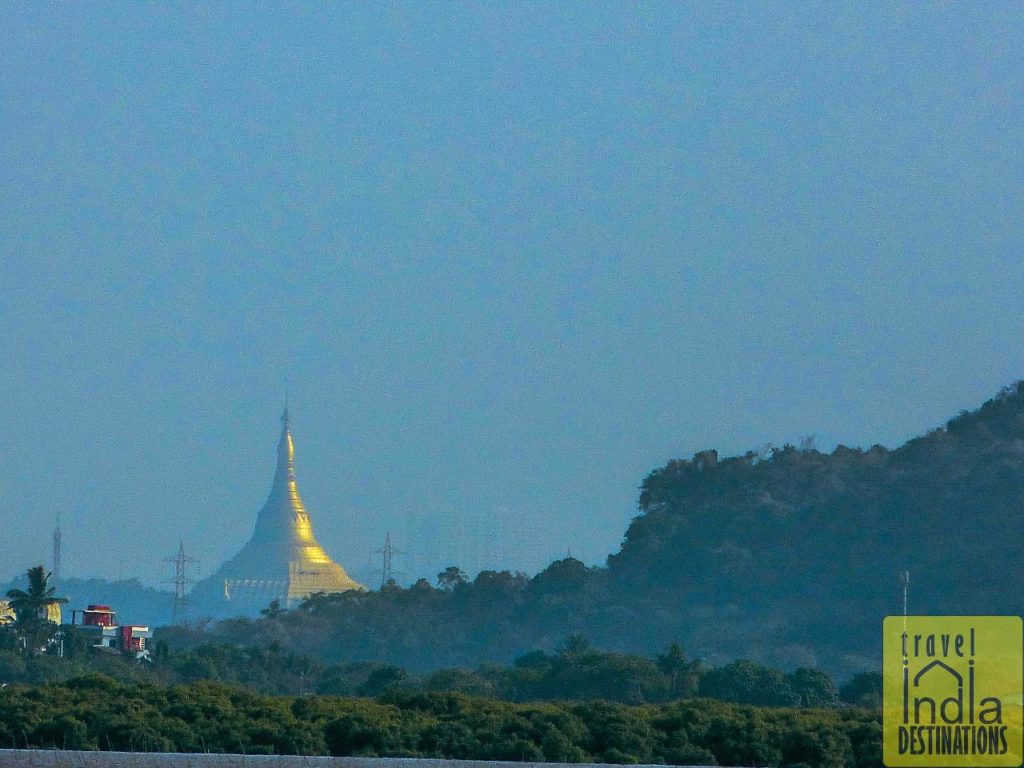
Global Pagoda Visible from Vasai Fort
Before I proceed, I would like to thank Mr Agarwal for his immense support and Mr Ashok for providing us in-depth knowledge and information about the Global Vipassana Pagoda, its architecture, its vision and mission and its philosophy. Also, I would take this opportunity to say that all the images below are courtesy of Global Vipassana Pagoda.
Understanding Vipassana
The word Vipassana literally means Insight in the ancient Pali language in India. It is a process of personal purification of the mind and the essence of the teaching of the Buddha. Those who follow it and practice it clearly state that there is no mysticism in it. You don’t get any super powers by practising it, and that no magic happens instantly.
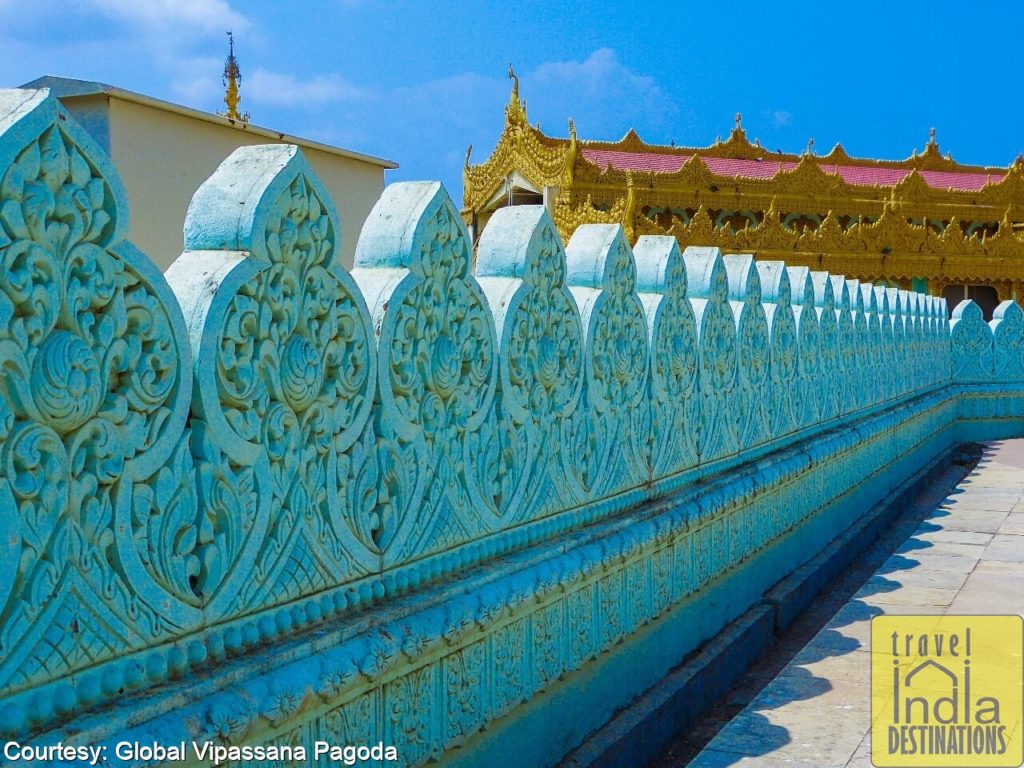
Architecture around the Global Pagoda
Vipassana is a simple logical way to achieve real peace of mind. It eliminates ignorance, greed, anger and fear that corrupt all relationships from family to global politics. The good thing about it is that anyone irrespective of race, caste or creed can practice it.
Reintroducing Vipassana in India
This practice is one of the most ancient meditation techniques in the world. Gautama the Buddha rediscovered it around 2500 years ago. Gradually, the technique spread to neighbouring countries like Myanmar (Burma), Thailand, Sri Lanka and other parts of Asia. Five centuries after Buddha the technique lost its value in India and disappeared. However, a chain of devoted teachers kept it alive for over 2000 years in Myanmar (Burma).
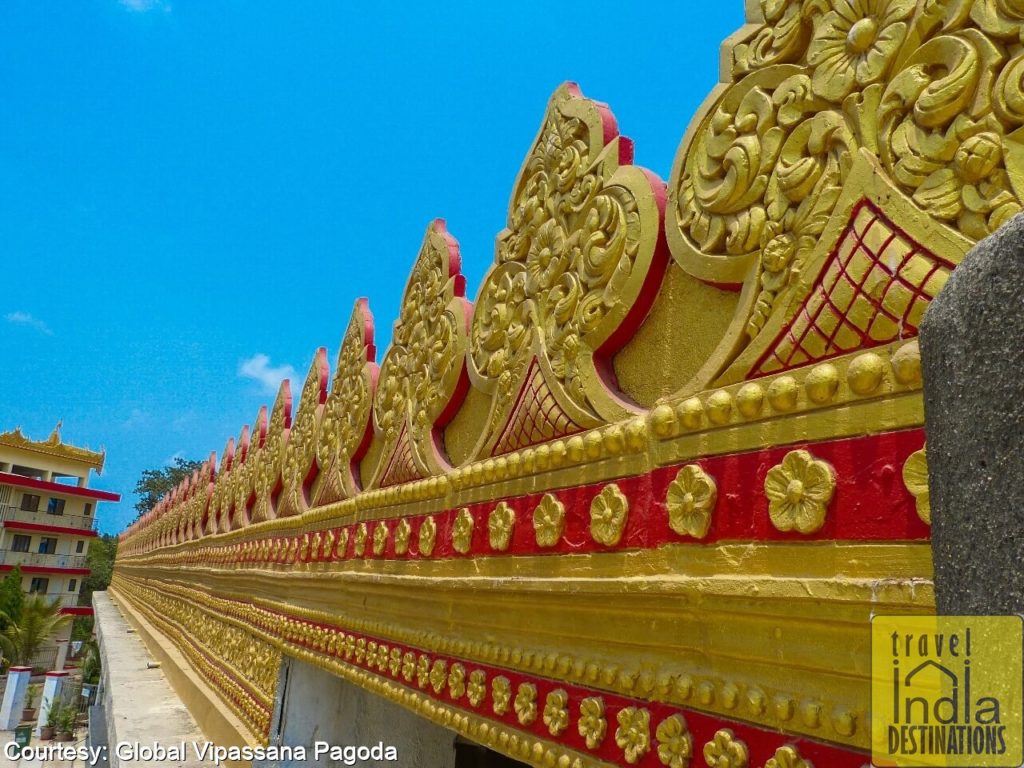
The Burmese style architecture of Global Vipassana Pagoda
Born in Mandalay, S. N. Goenka (a leading industrialist in Myanmar) was a renowned teacher of Vipassana meditation and followed the tradition of Sayagyi U Ba Khin. After training for 14 years, S. N. Goenka was authorised (in 1969) to reintroduce the technique of Vipassana in India. For Sayagyi, this was a dream come true. He strongly wished that the technique should return to India, the land of its origin. In 1976, S. N. Goenka established the first Vipassana meditation centre in Igatpuri near Mumbai. He also gradually spread the technique to other parts of the world and established around 170 centres worldwide. He along with his wife Mrs Goenka conducted Vipassana courses and trained over 800 assistant teachers in India and abroad.
Constructing the Global Vipassana Pagoda
The origin of the concept of pagoda dates back to 3rd Century B.C.E. This dome-shaped structure is a commemorative monument and stores the sacred relics. You’ll find pagodas across the globe and they symbolise the widespread teaching of Buddha.
The planning of the Global Vipassana Pagoda began in 1997, but the construction began in 2000. There are three sub-domes. The design is the replica of the Shwedagon Pagoda in Yangon, Myanmar. This is to show the gratitude of India to Myanmar for preserving the technique of Vipassana.
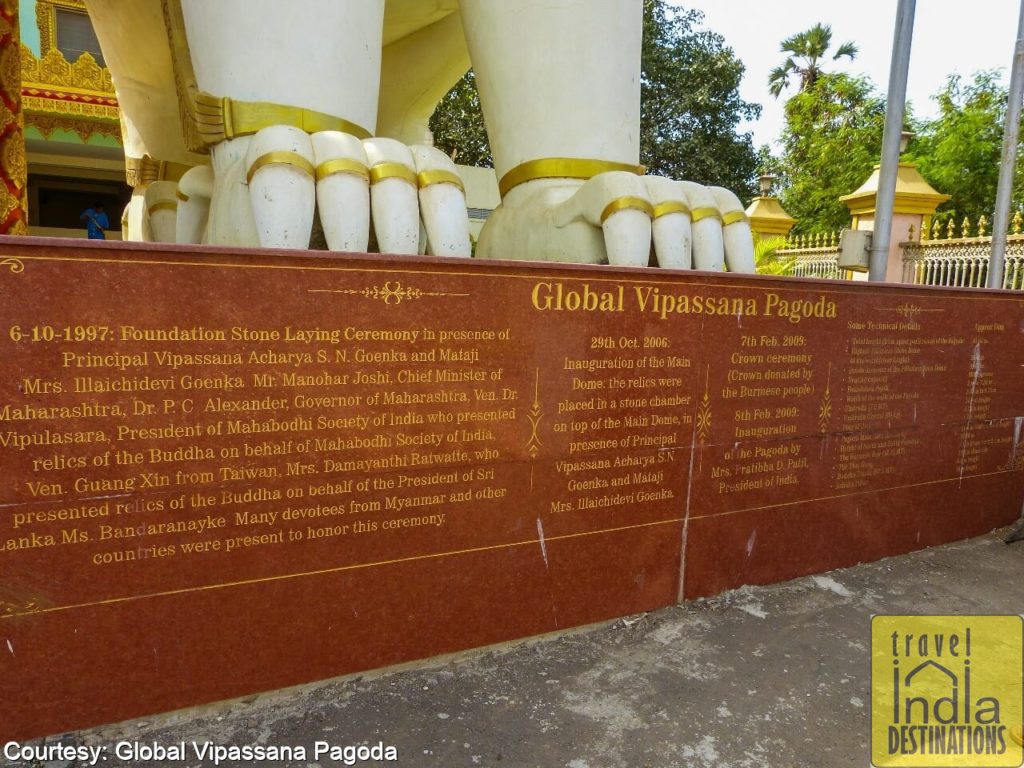
Global Pagoda Information at the Myanmar Gate
There are three sub-domes in the main pagoda. The first dome is the largest of all and contains the bone relics of Gautama Buddha place in the ceiling stone. This dome serves as a large meditation hall. You cannot take pictures inside the dome. However, I can say that anyone who has the slightest interest in architecture will be simply blown away. It is the world’s largest hollow stone masonry structure and measures 6000 sq. m. (65,000 sq. ft.).
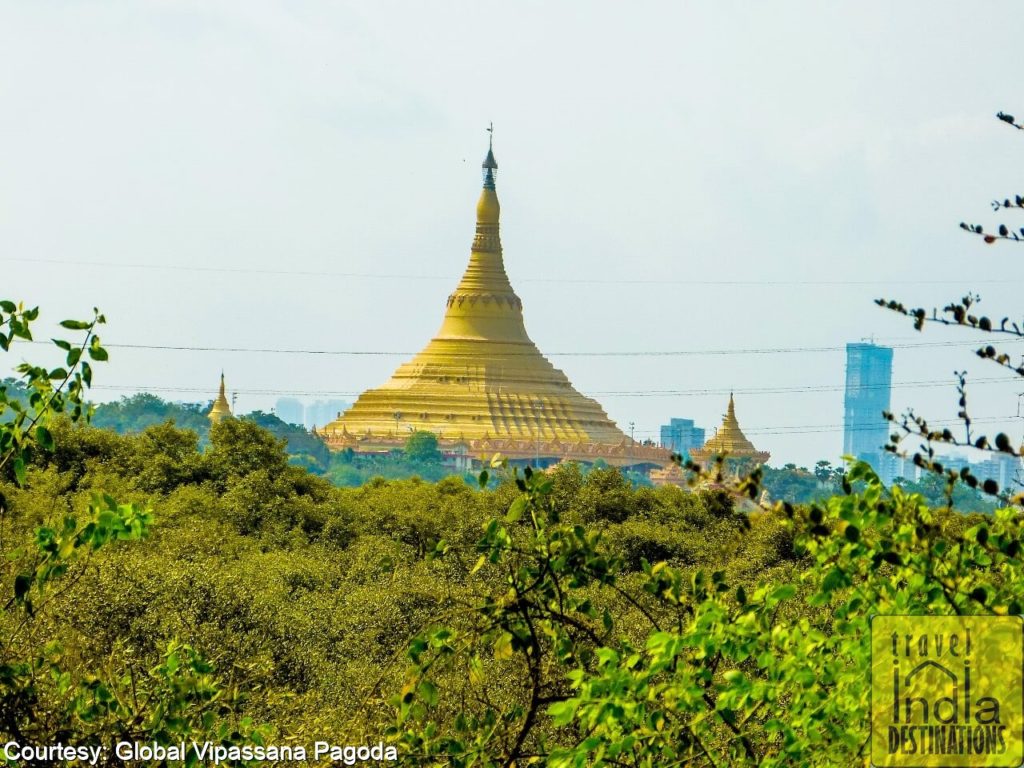
The Global Pagoda structure can be seen from a distance.
This large hall can accommodate 8000 people at one time. The experience of standing in the hall feels like you’re standing in a giant ball because there are no pillars at all. The pagoda uses the technique of interlocking stones which is quite rare. The height of the pagoda is 325 feet which equate to a 30-storey building.
It took 11 years, 3.87 million man-days, and 2.5 million tonnes of stone to complete the monument. Workers from all over the world worked selflessly and tirelessly to complete the monument in time.
The number 24 plays an important role in Buddhism. The Dhamma Wheel has 24 spokes and they represent the Twelve Links of Dependent Origination and its reversing. The Twelve Links focus on how life arises, exists, continues and ceases. The other twelve focus on liberation from Samsara (endless cycle of birth, death and rebirth).
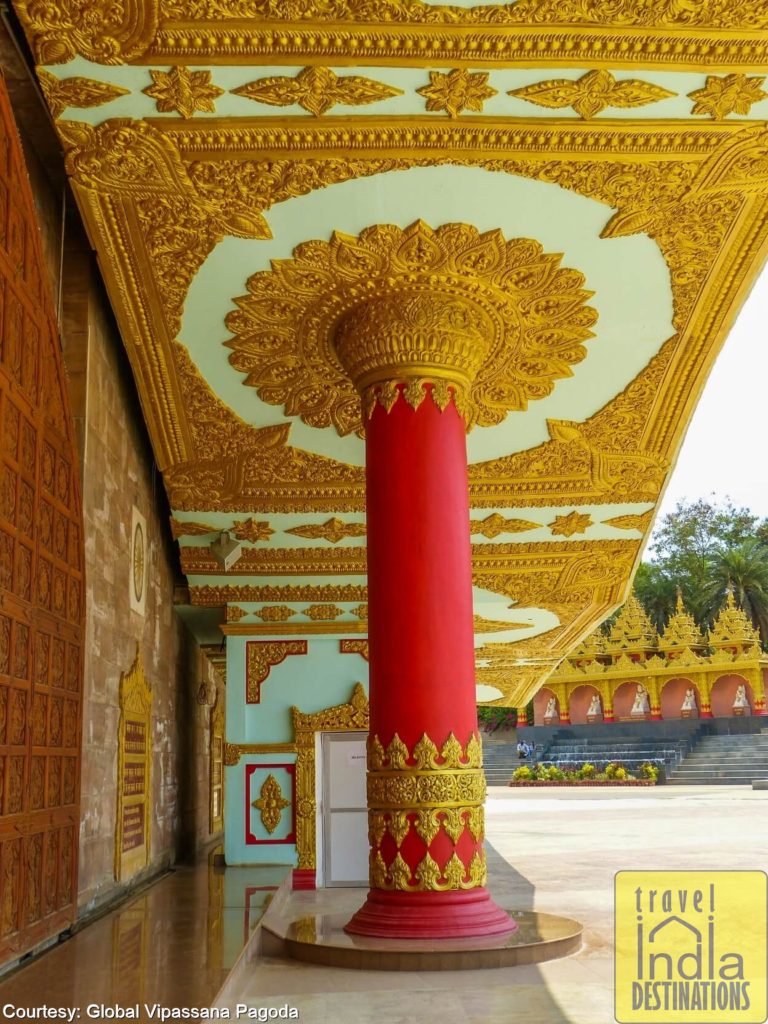
There are 24 of these pillars supporting the main pagoda.
The pagoda structure intelligently infuses the concept of number 24 in its architecture. There are 24 exterior pillars that support the main pagoda. The main pagoda structure has 24 air vents. It has 24 doors (there are 8 gates and each gate has 3 doors) to enter and exit the main pagoda.
How to Get Here:

Take the Bus No. 4
Global Vipassana Pagoda is right next to the Essel World. If you are planning to visit this place I would recommend you check the official page for reaching the pagoda. You can take Bus No. 4 from Bhayendar West and it will drop you right at the pagoda. The bus ride takes around 30 minutes and the bus ticket cost is around Rs. 22/- per person.
Myanmar Gate
Built as a symbol of gratitude towards the people of Myanmar, the design of this gate is simply awe-inspiring. The intricate Burmese design takes inspiration from the gates of Shwedagon Pagoda in Yangon, Myanmar.
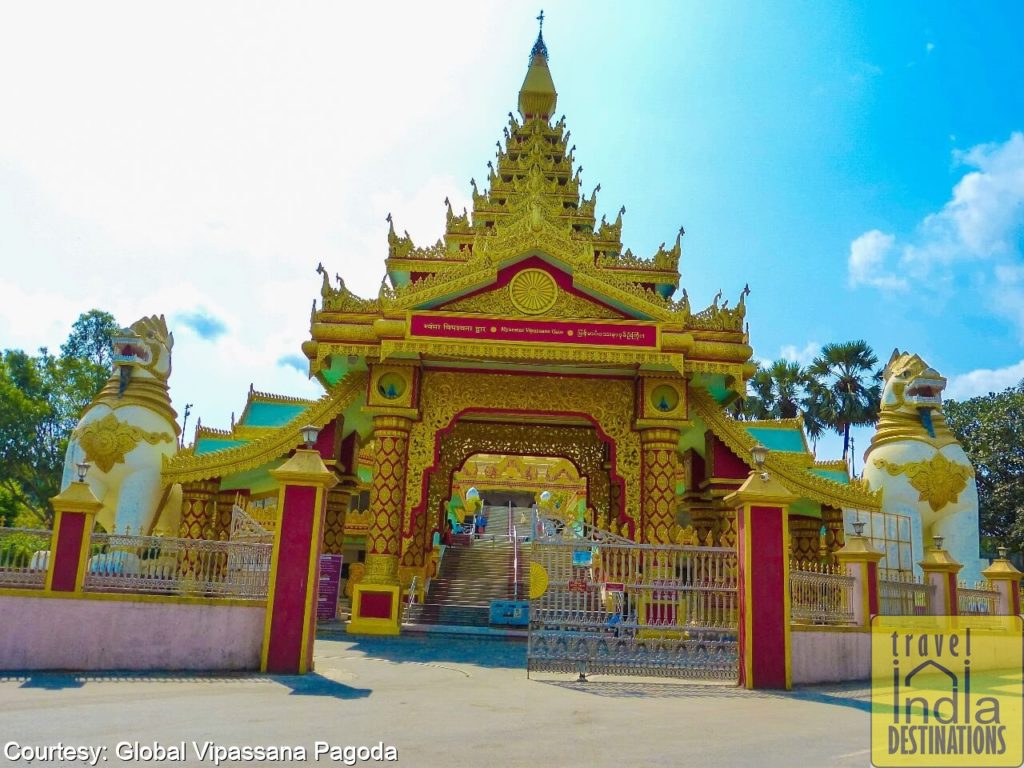
The Myanmar Gate View
The gate has 12 pillars in all (4 main pillars and 8 subordinate pillars). These pillars support seven tiers that rise from the roof of the arch to the top. On both sides of the gate, we see lions (symbol of protector) and they reflect the Burmese culture. The tall pagoda structure looks magnificent from the Myanmar Gate.
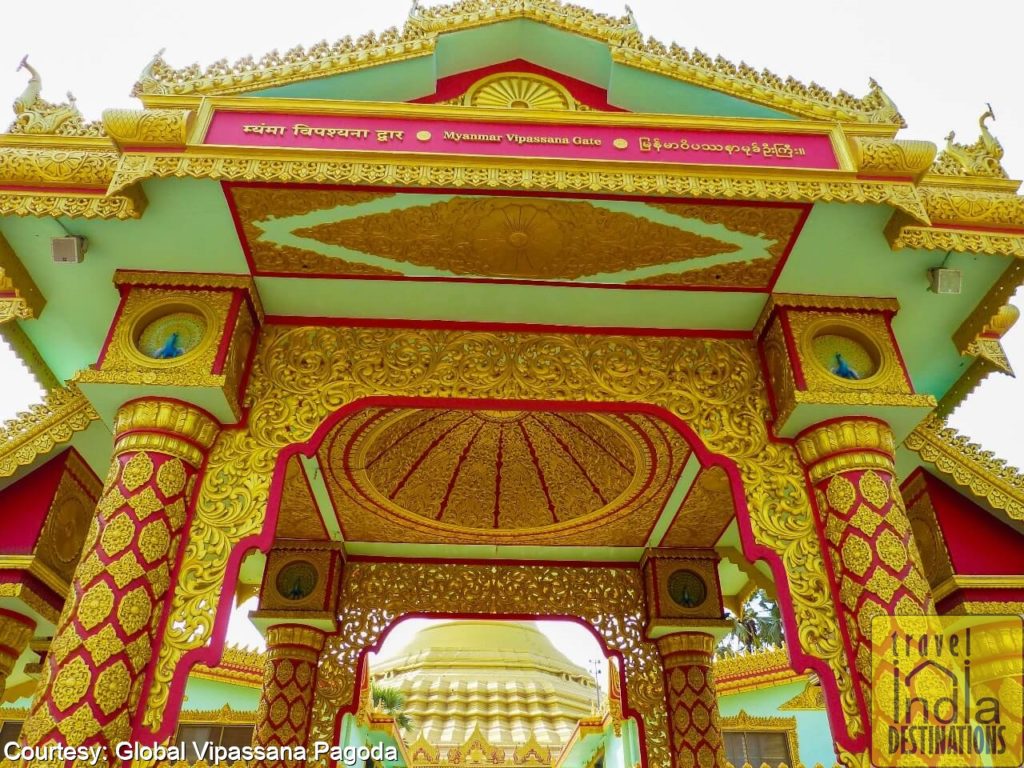
The golden red colour combination is just spectacular.
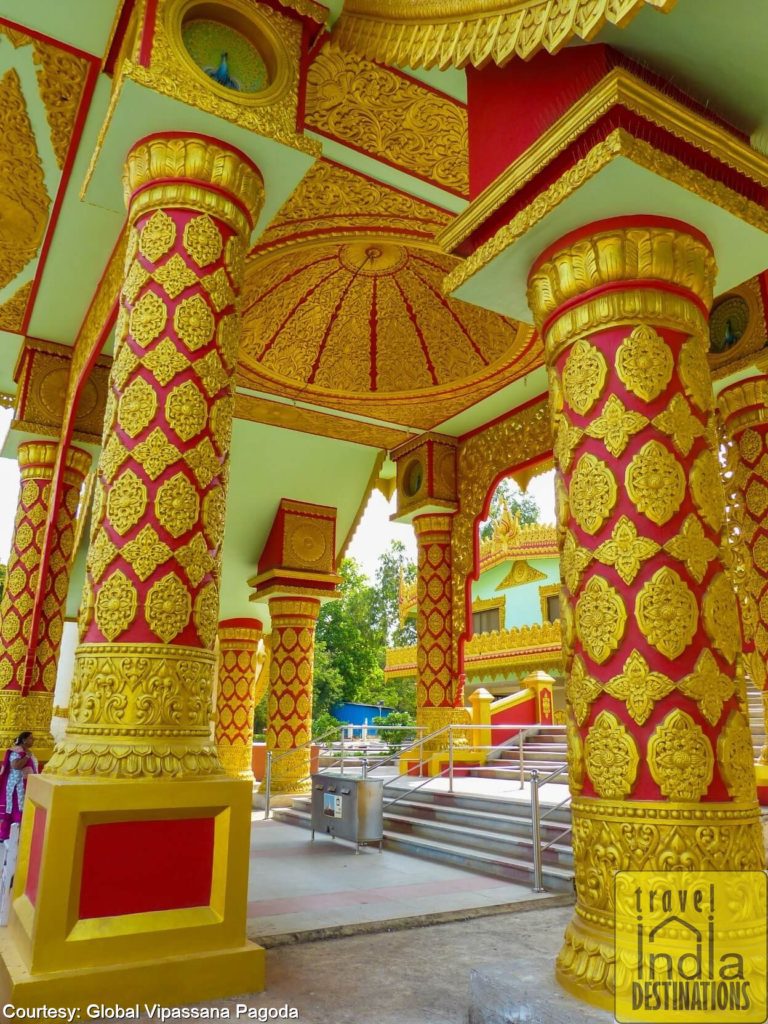
The four main pillars of the Myanmar Gate
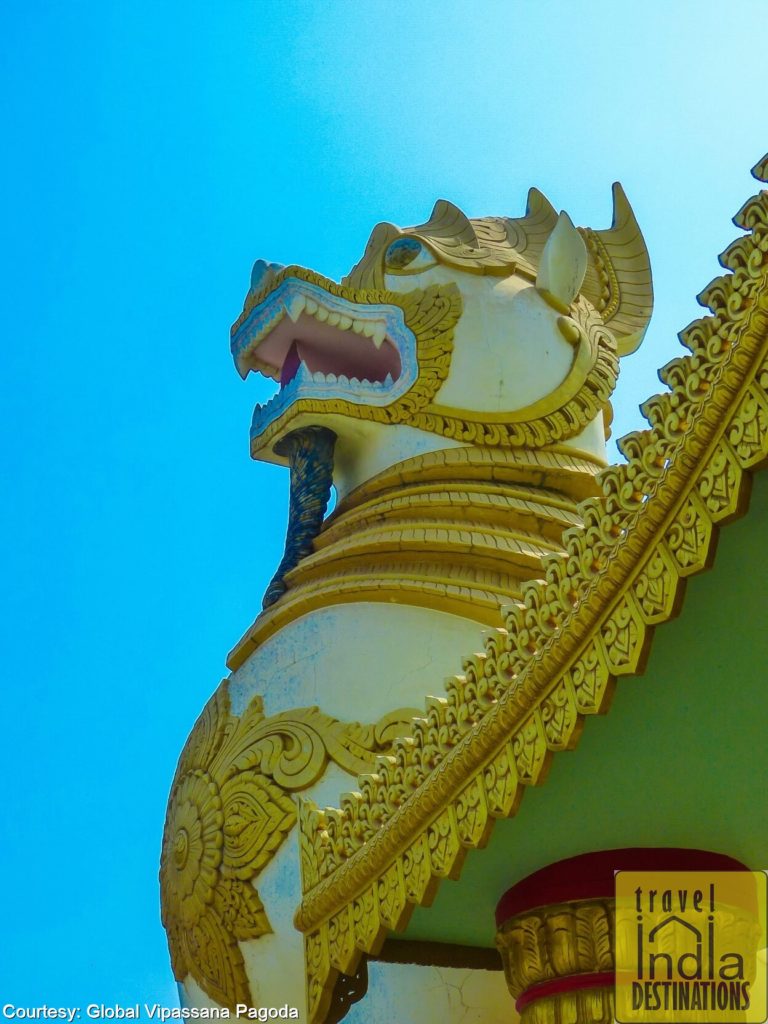
The lion on the side of the Myanmar Gate guards the pagoda.
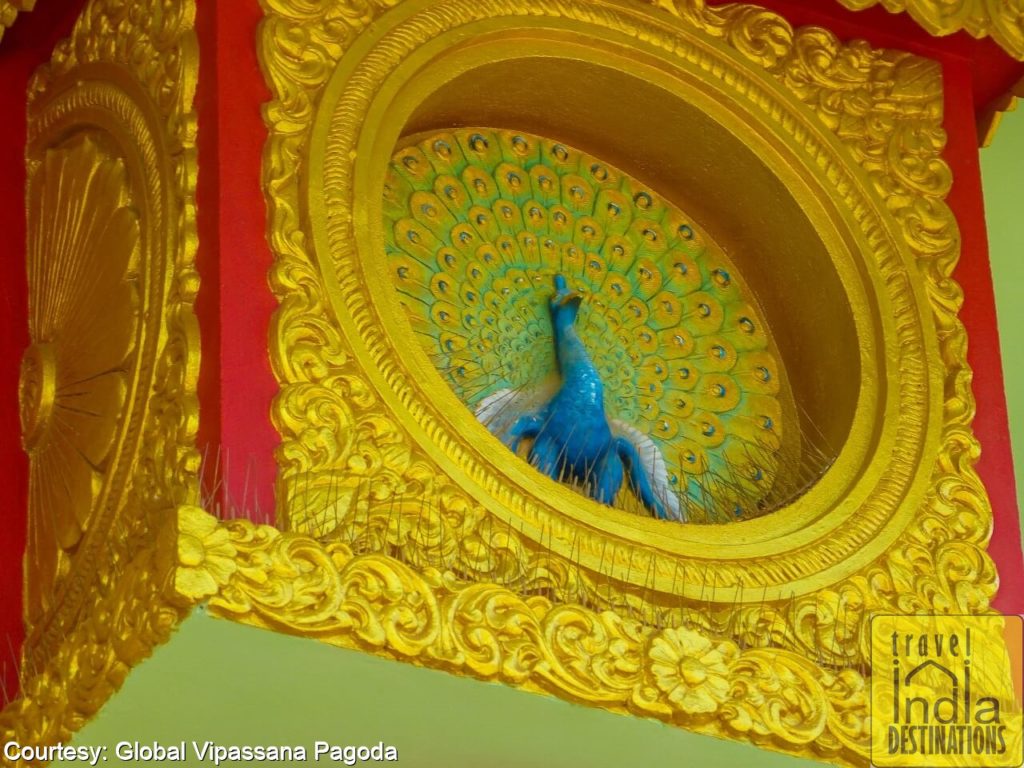
The intricate work done on the Myanmar Gate

The view of the pagoda from the Myanmar Gate. Info Centre on left, Souvenir Shop on the right.
The moment you take the stairs you come to Info Centre on the left. This is also the security checkpoint and therefore no photography is allowed here. Right opposite to the Info Centre is the Souvenir Shop where you can shop on your way out.
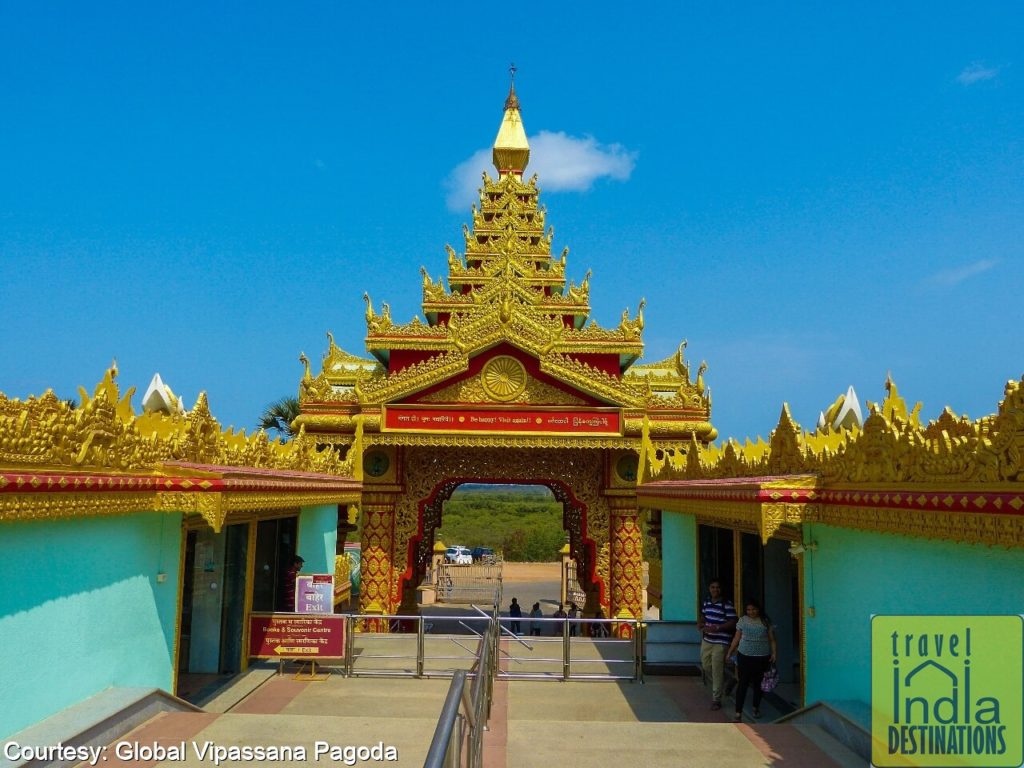
A look at the Myanmar Gate after passing the Info Centre on the right.
The Bell Tower & The Gong Tower
After a few steps up, you come across a wide space that has two breathtaking open structures. The Bell Tower on the left holds a massive bell donated by the meditators of Myanmar. The bell weighs 13.11 metric tonnes (13110 kilogrammes) and is 10 feet tall.
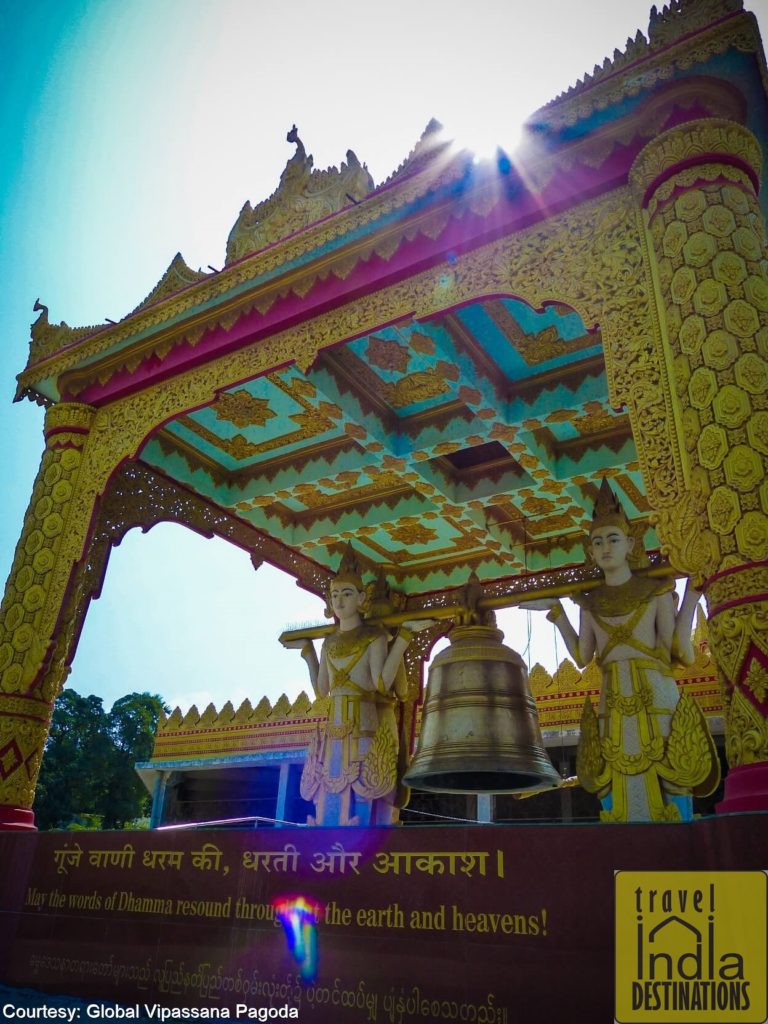
The Bell Tower on the left side
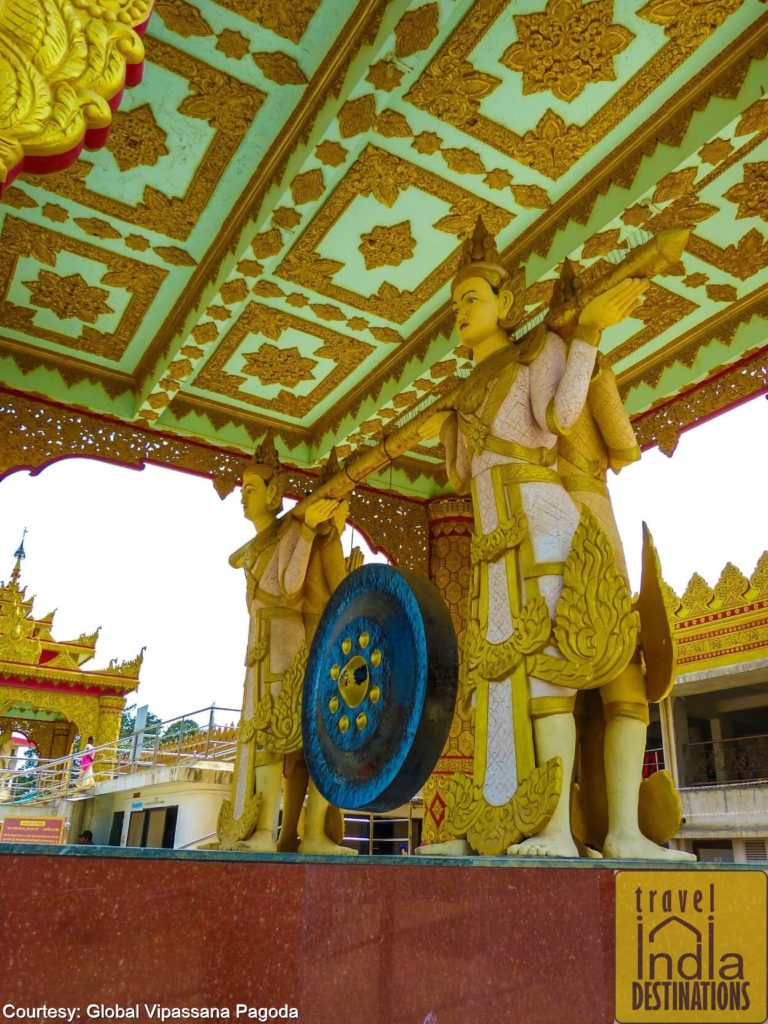
The Gong Tower on the right
The Gong Tower holds a massive circular gong donated by the meditators of Thailand. A few steps right of the Gong Tower is the food court where you can have some refreshments. There’s a Dhammalaya on the left which is a building for meditators. The building has 34 twin bed AC rooms and 7-bed dormitory along with dining and kitchen facilities for guest groups.
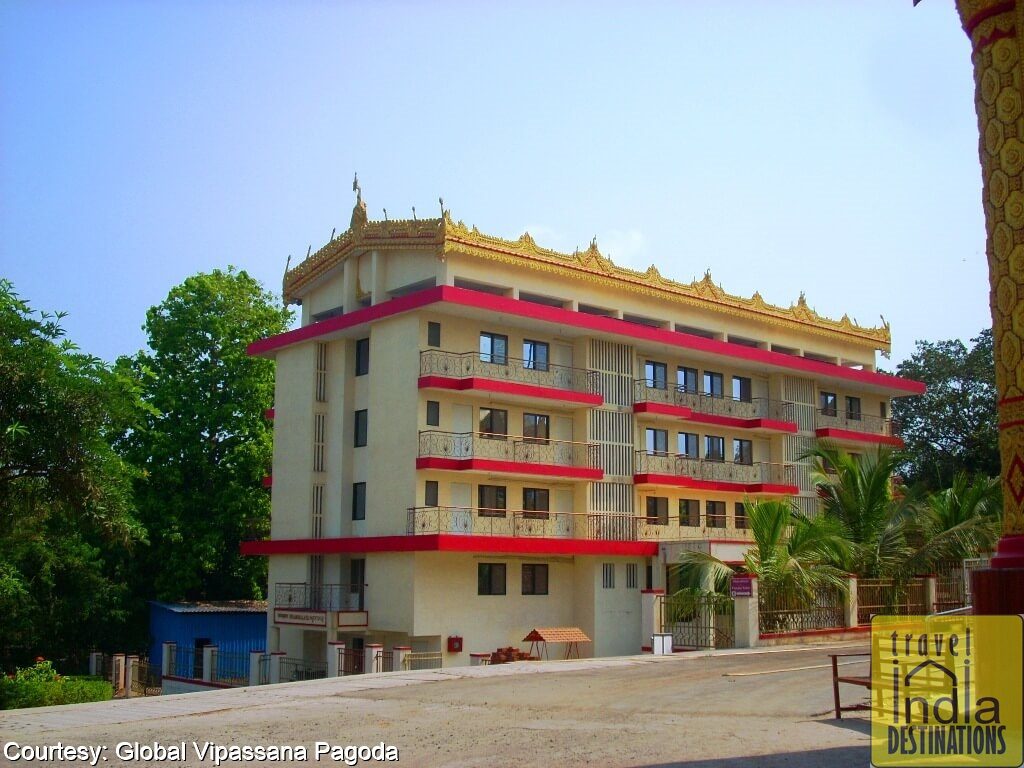
Dhammalaya – a residential building for the meditators
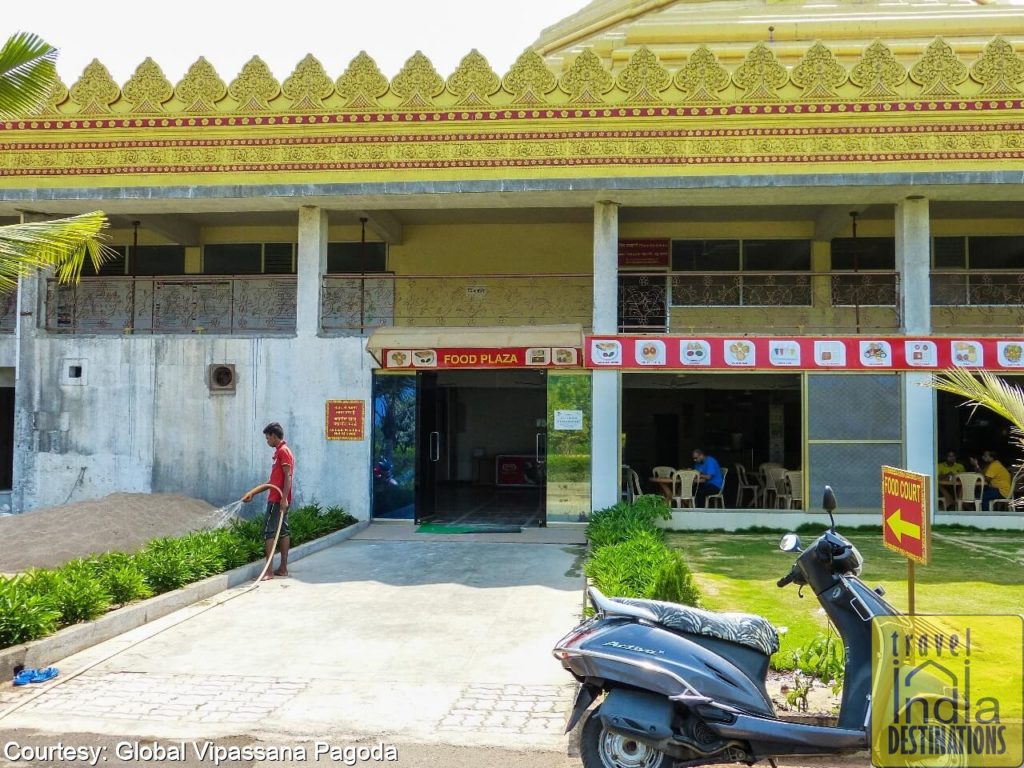
The food court at the Global Pagoda
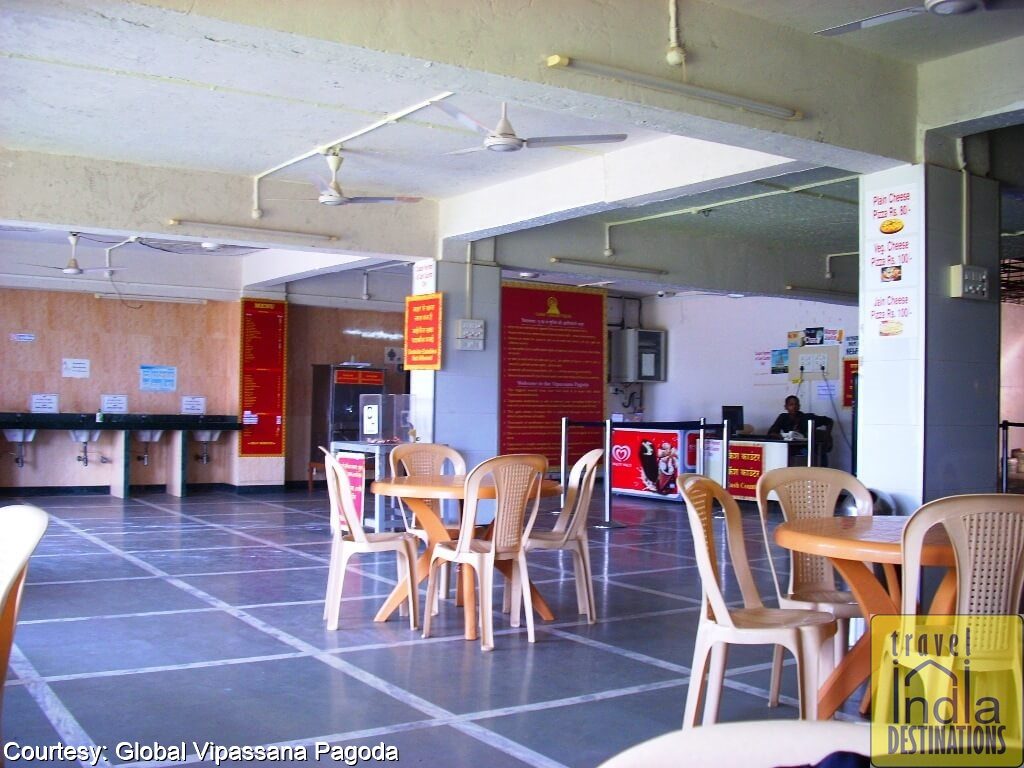
Inside the food court.
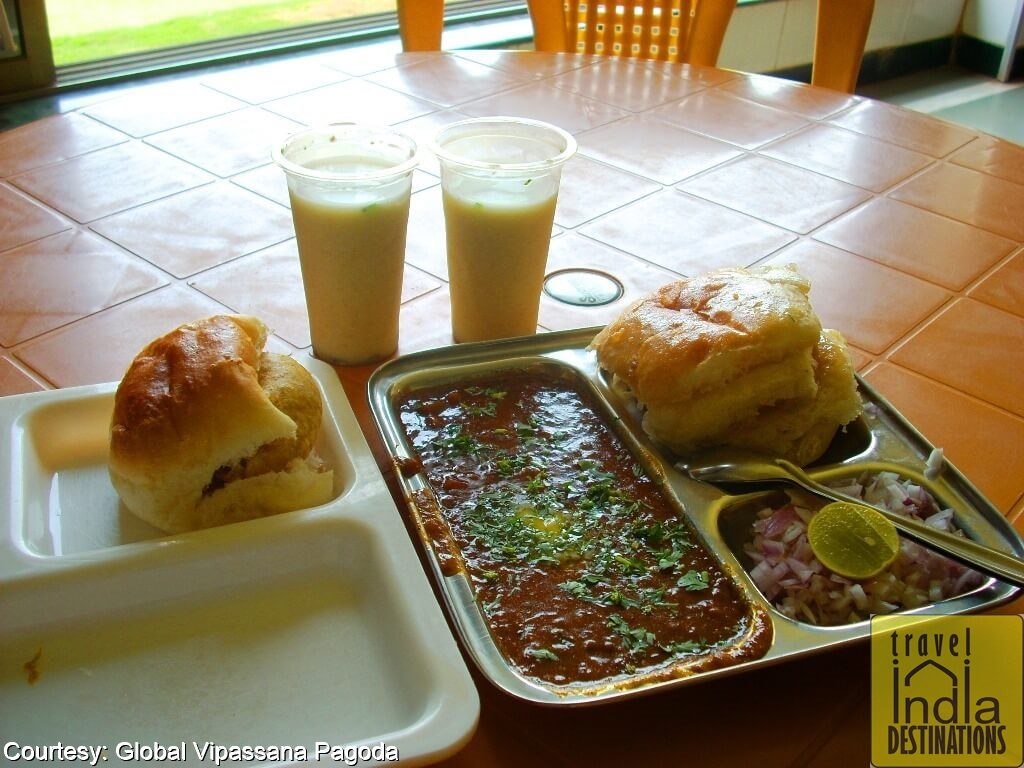
A delicious Pav Bhaji and some buttermilk
Statue of Gautama The Buddha
When you are near the food court you can’t miss the statue of Gautama the Buddha. This statue symbolises respect towards the enlightenment of Gautama the Buddha. Carved from a single rock of marble this statue is 21.5 feet high and weighs 87.5 metric tonnes. The statue shows the Buddha in a seated meditative position.
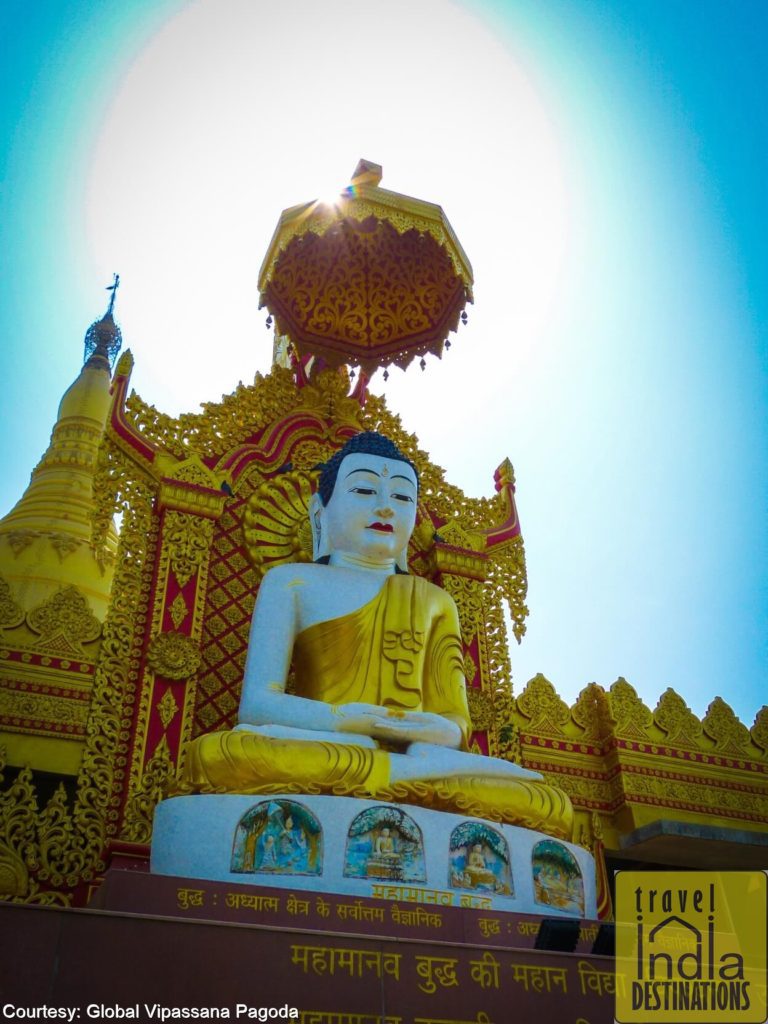
Lord Buddha statue outside the food plaza
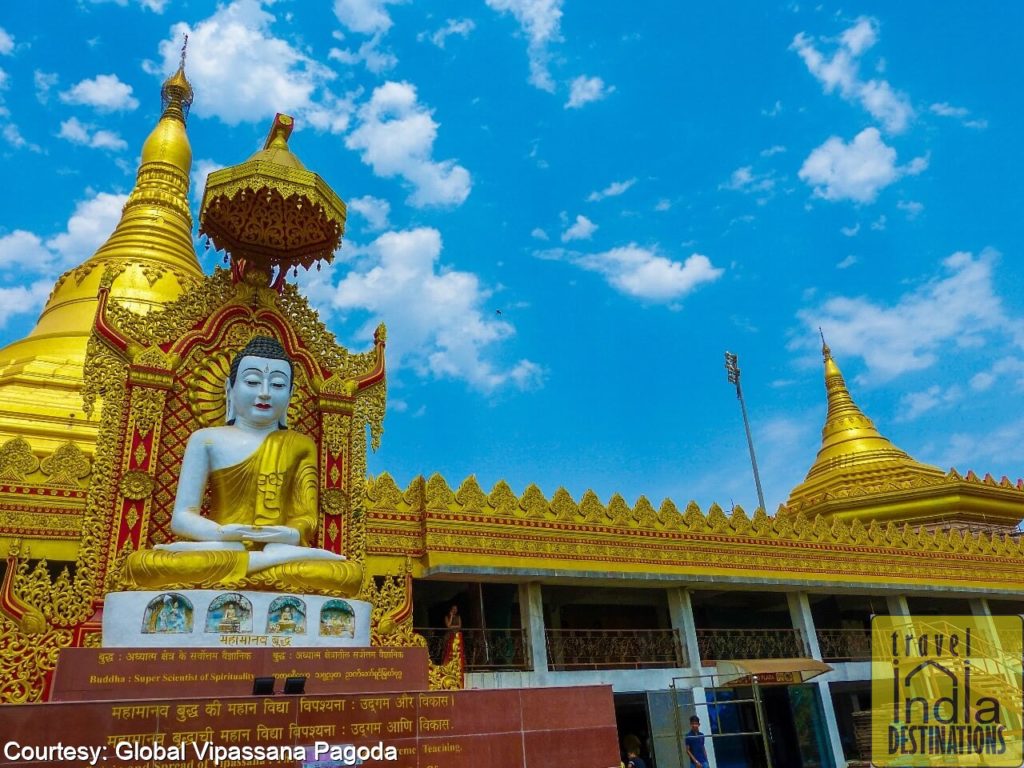
A wider angle that captures more details.
The road ahead is not open for visitors and therefore you return to the stairs near the Bell Tower and the Gong Tower and climb upwards. When you reach the top you come to the Gate No. 5 of the Global Vipassana Pagoda.
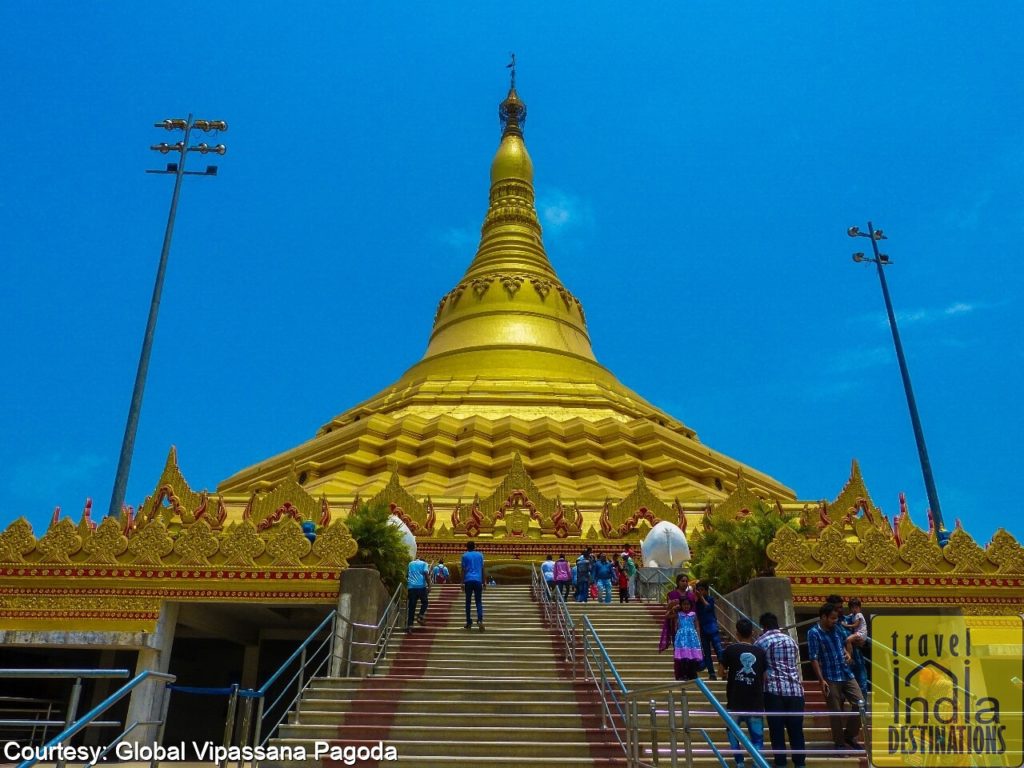
You climb up to the next level
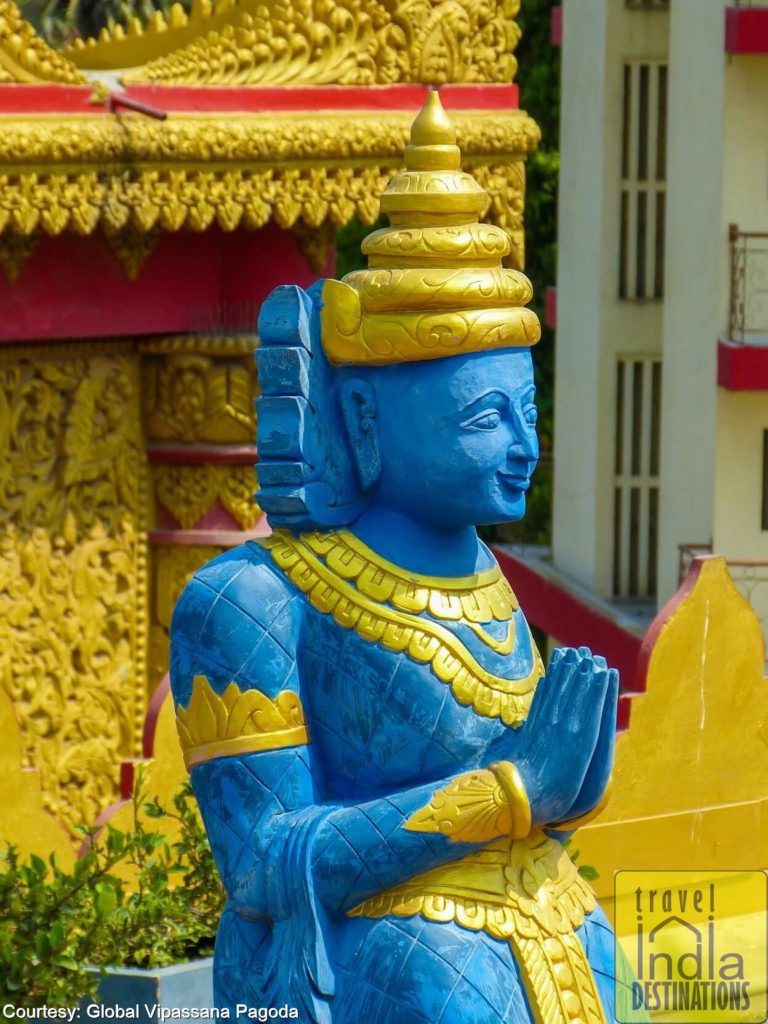
Bhumi Devata – The Earth Deity
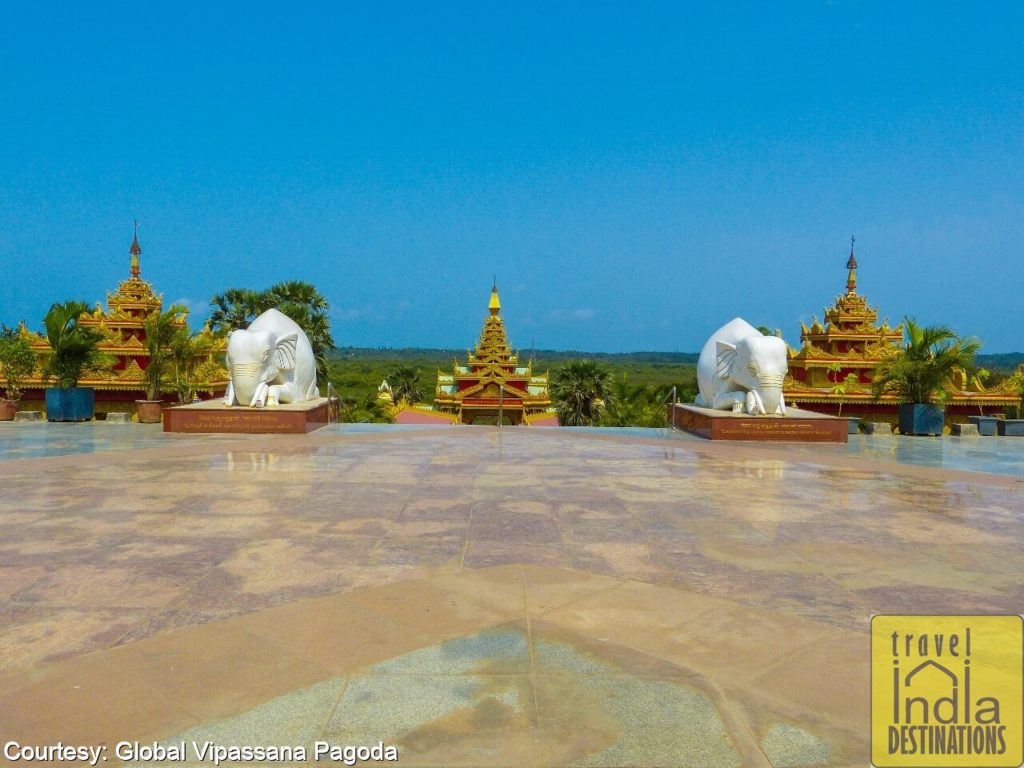
A View of the Myanmar Gate from the top.
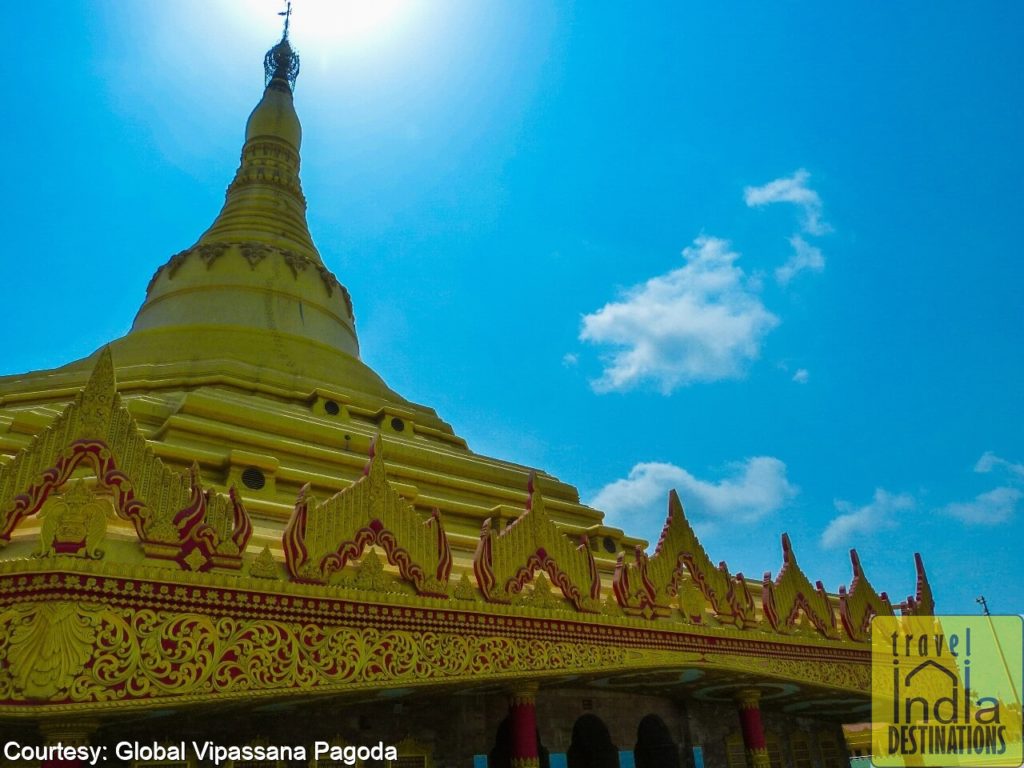
The Global Pagoda View on reaching the top level.
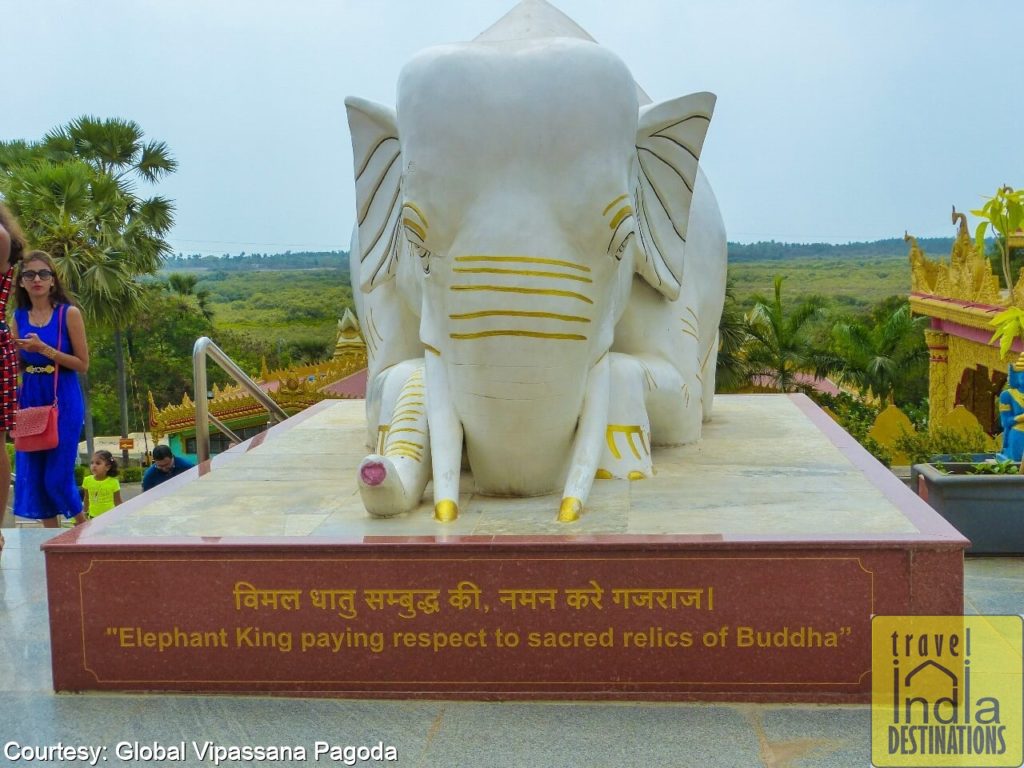
The Elephant King Statues
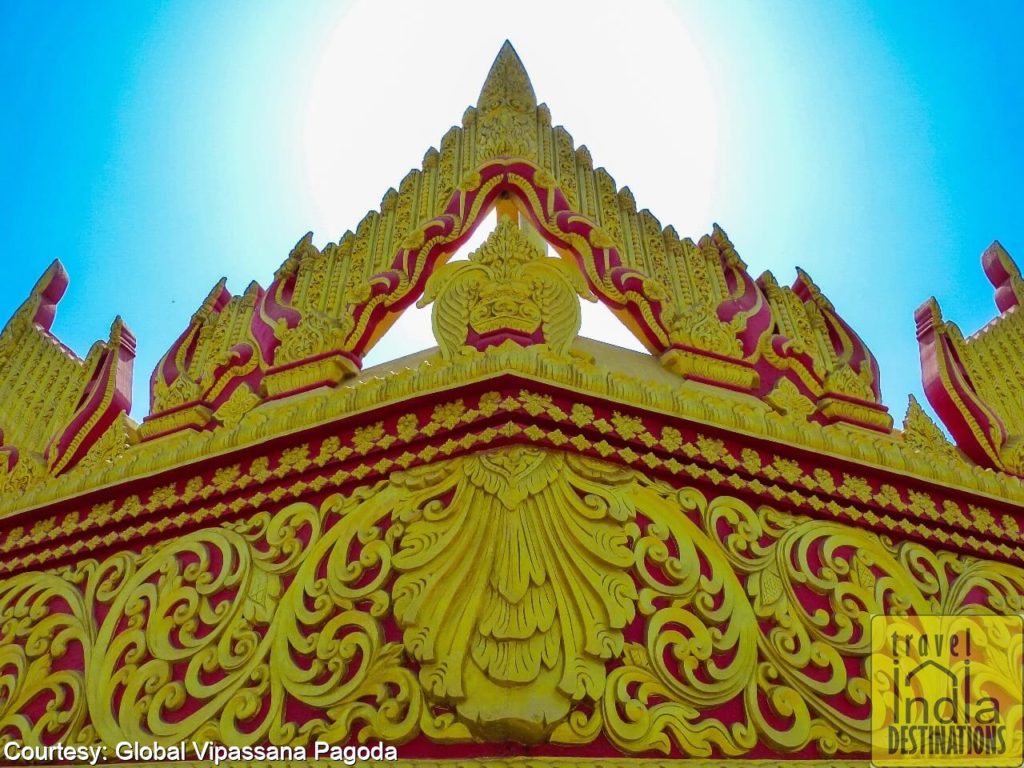
The motifs on the Global Vipassana Pagoda structure
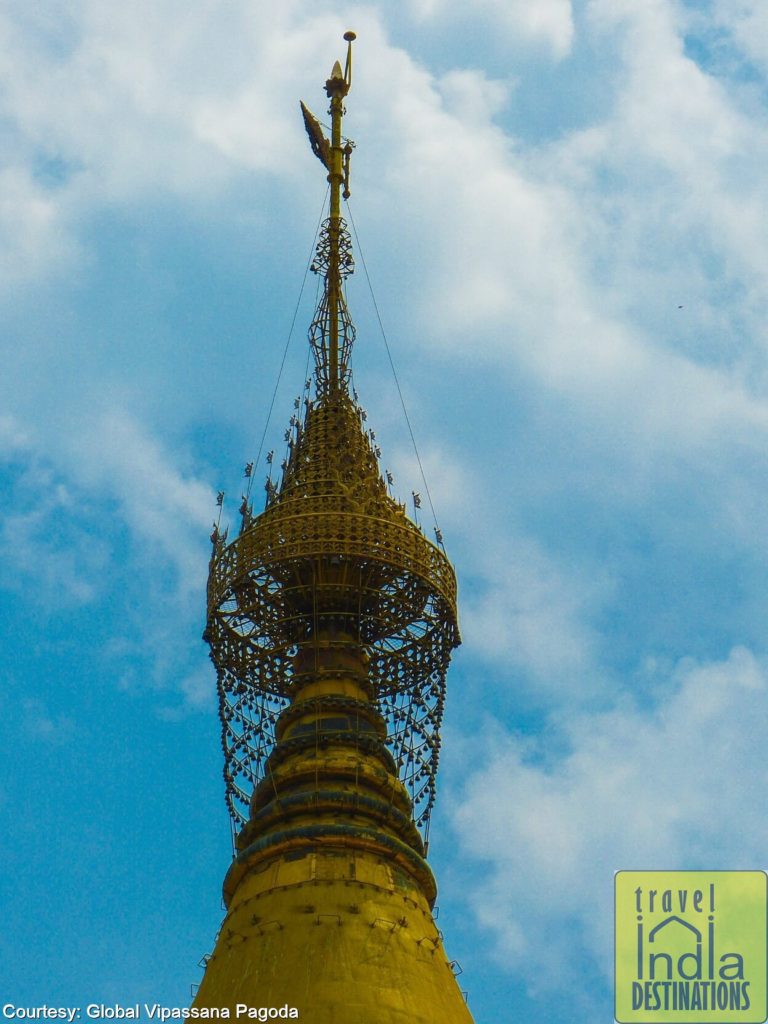
The spire of the Global Vipassana Pagoda
The view of the pagoda structure and the Myanmar Gate down below is equally spectacular. As you move further left from here you come across a smaller version of the pagoda which is the North Pagoda.
The North Pagoda
The North Pagoda is a smaller version of the main pagoda. It is 60 feet tall and covers 1700 sq ft area. The pagoda is created in stone masonry and the 7.5 feet canopy has no pillar support which is the unique aspect of its construction.
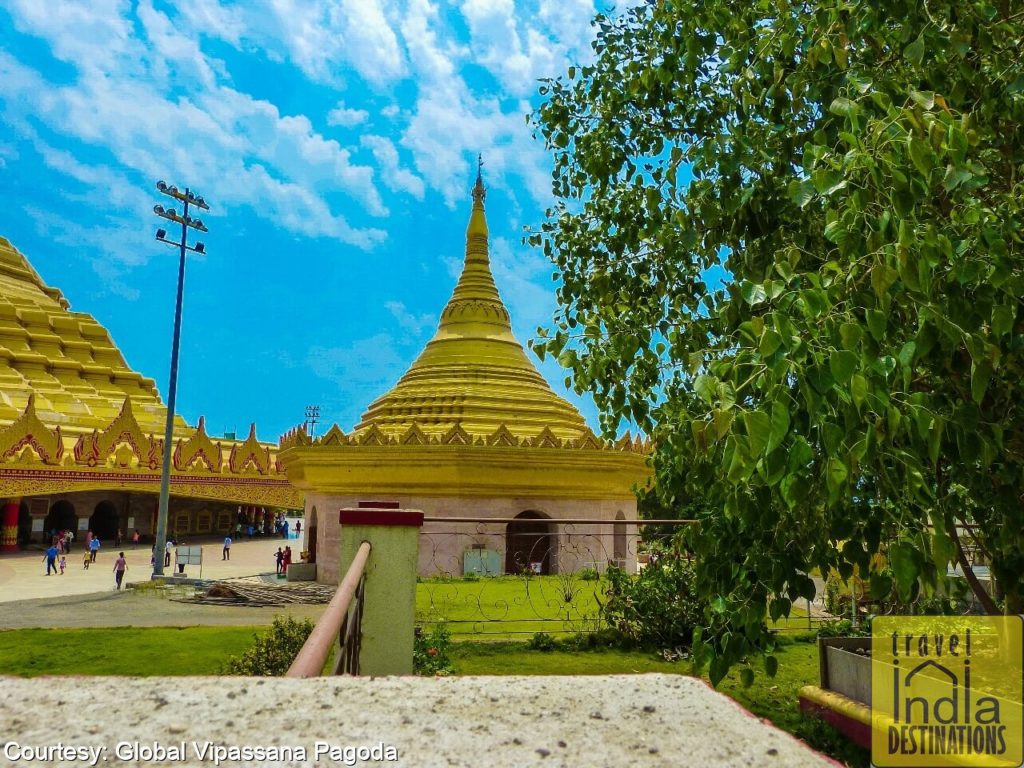
The North Pagoda with the Bodhi Tree
North Pagoda is used for conducting mini Anapana sessions. This is the first step of learning Vipassana for visitors. The sessions are around 15 minutes long and they offer a mini-window to the visitors of what it would be like if they take up Vipassana courses. The structure can withstand harsh weather and earthquakes.
Gate No. 7
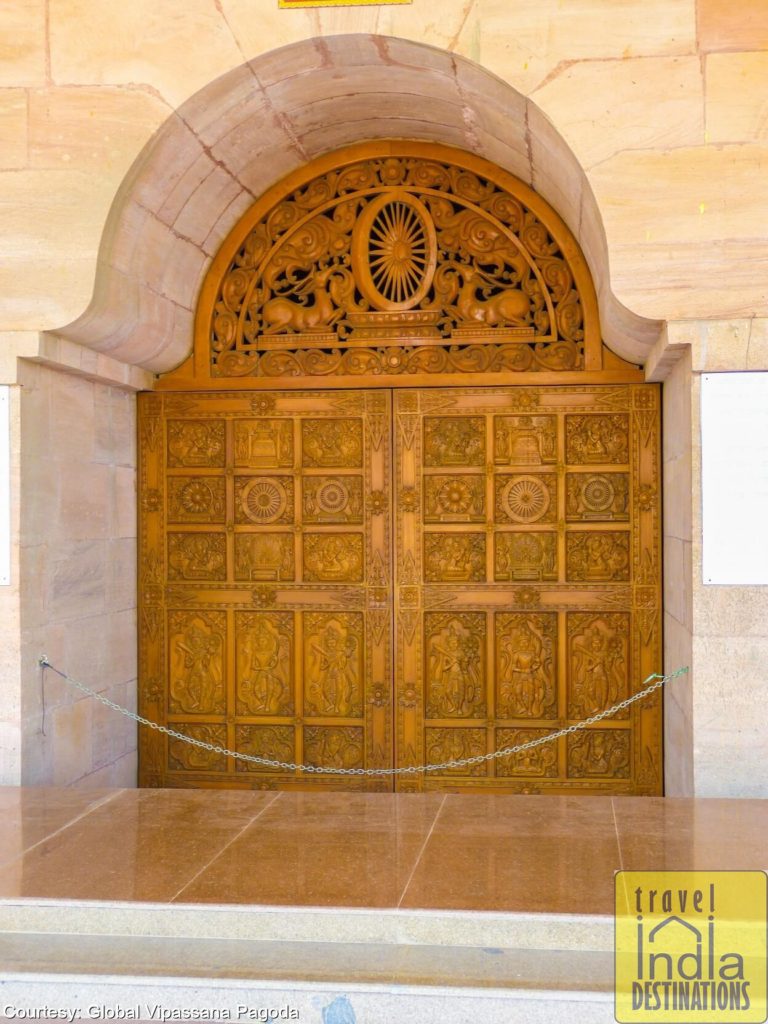
The carved door near Gate No. 7 made from Burma teak wood. Dhamma Wheel and Sarnath Deers on the top.
Right opposite to the North Pagoda is Gate No. 7 which is the only door open for visitors to take a quick look at the main pagoda structure from within. Visitors have to switch off their mobile devices and camera before entering the main pagoda. You need to maintain silence when you are inside the main pagoda structure to ensure not to disturb the meditators in the hall. The exit is from Gate No. 8.
Saddhamma Sri Mahabodhi Tree
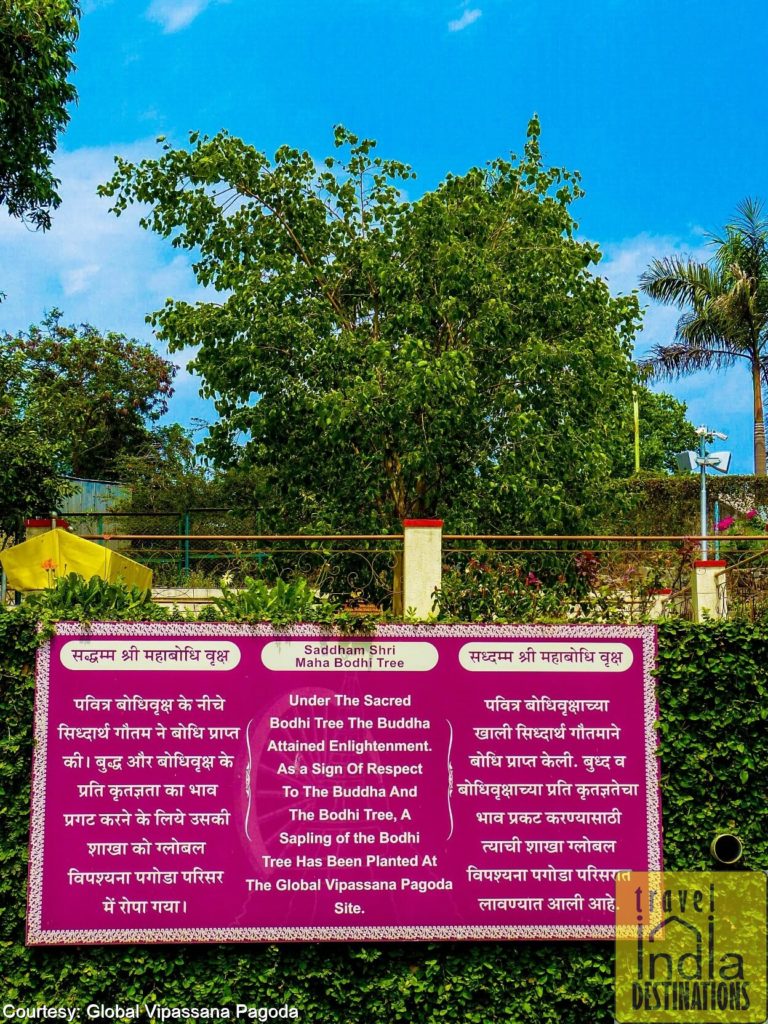
The Maha Bodhi Tree at the Global Pagoda
When you walk out of Gate No. 8 far in the distance you will notice a tree. From a distance, it might seem like an ordinary tree, but it is not. The Buddha got enlightenment in Bodh Gaya under a Bodhi Tree. Emperor Ashoka’s eldest daughter Sanghamitta embraced Buddhism and was ordained into Theravada Buddhism Order. She became an Arihant MahaTheri.
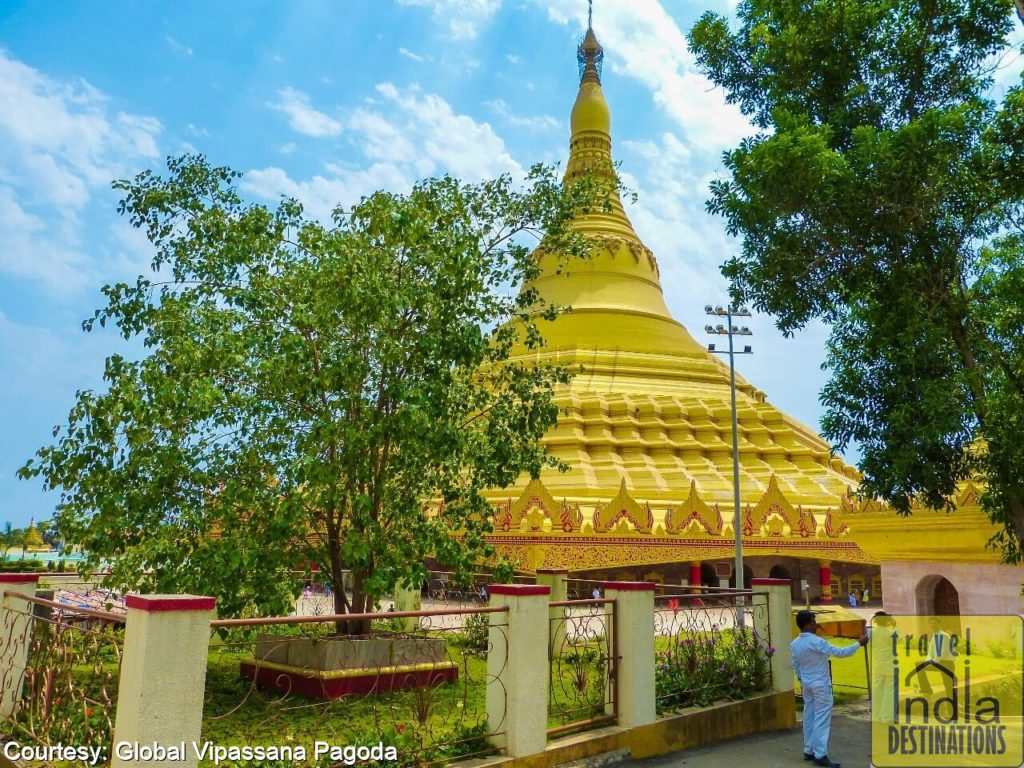
Maha Bodhi Tree with Global Pagoda in the background
When Emperor Ashoka decided to spread Buddhism in Sri Lanka Sanghamitta took a cutting of the southern branch of the said Bodhi Tree and carried it to Sri Lanka via sea. The sapling was planted and was known as Jaya Sri Mahabodhi and it still exists in Sri Lanka. As a sign of gratitude, the cutting from the same tree is planted in the Global Vipassana Pagoda on March 02, 2014. Hence, in a way the cutting of the same Bodhi tree under which the Buddha attained enlightenment has returned to its motherland after so many centuries.
Waterfall, Fountain and the Ashoka Pillar
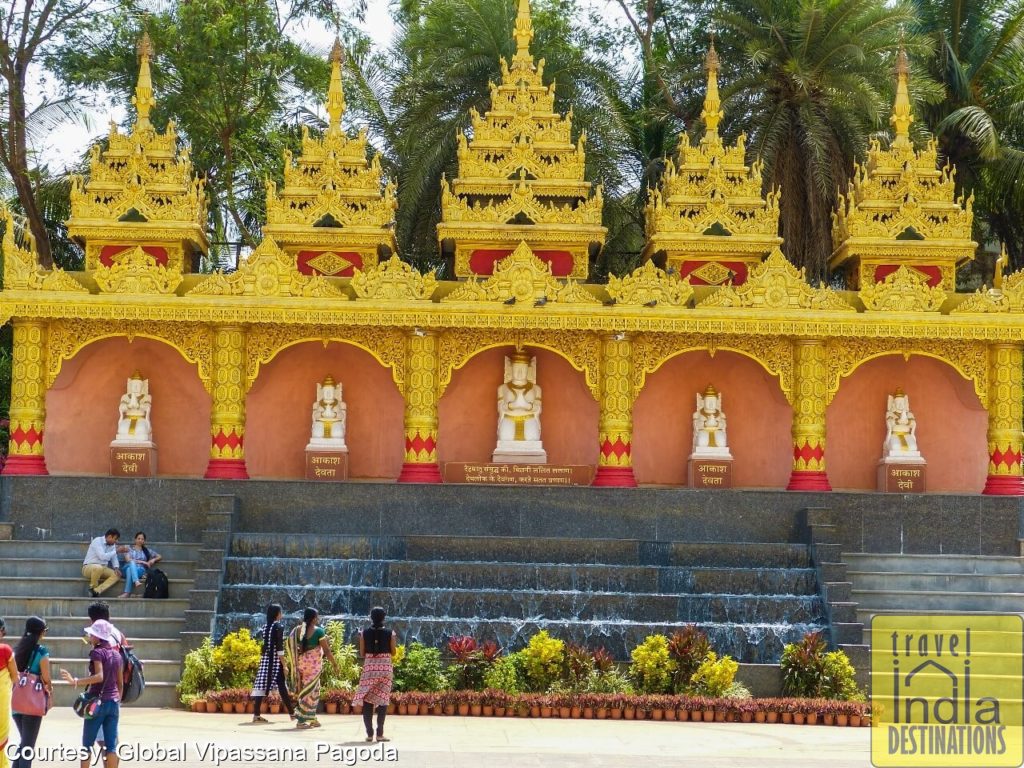
An amphitheatre style waterfall with 5 sky deities
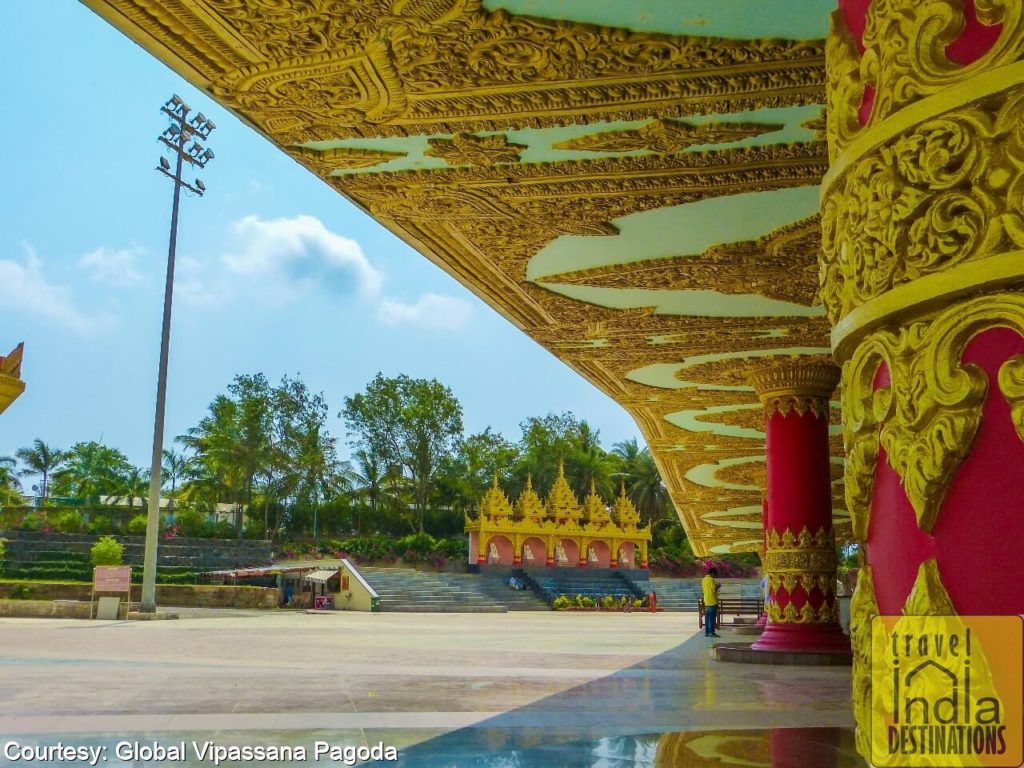
A View of the Waterfall
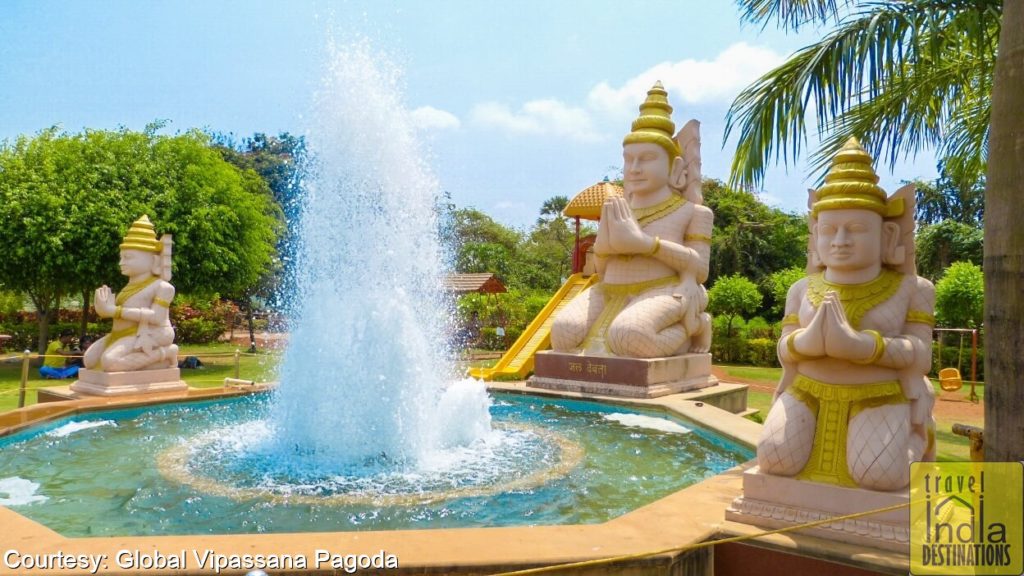
The fountain and the Water Deities
Right next to it is a mini food court and a waterfall with seating steps. It has five sky deities on the top that bestow respect to the enlightened one. There’s also a fountain surrounded by three water deities. You will also see kid’s play area here where kids can have some break time.
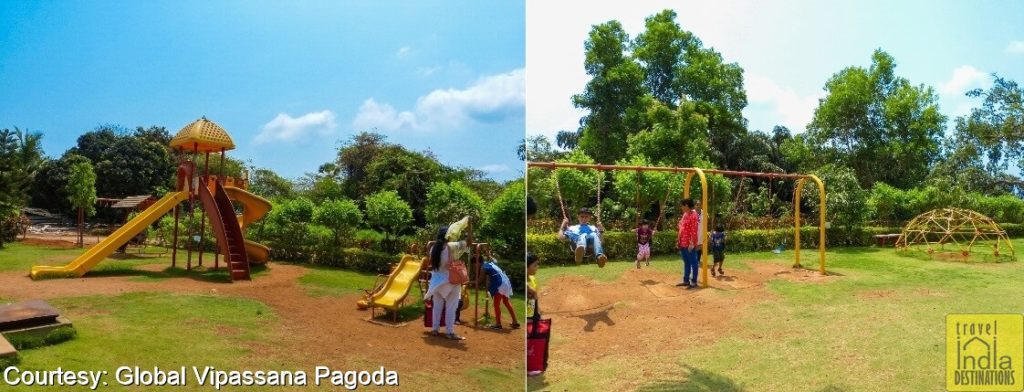
A play area for the kids
The Ashoka Pillar symbolises gratitude towards Emperor Ashoka who spread the teachings of Buddha outside India. The pillar is 52.4 feet high. This pillar is the replica of the Ashoka Pillar at Sarnath. A graphic representation of it was adopted as the official Emblem of India in 1950.
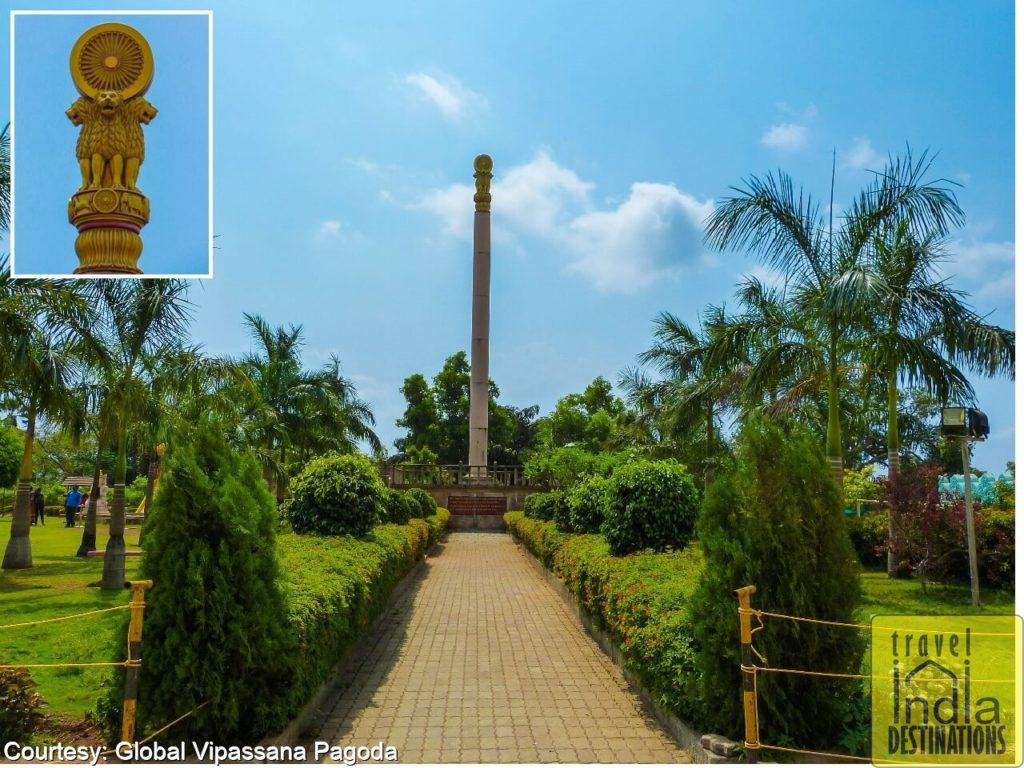
The Ashoka Pillar at the Global Pagoda
The pillar has four lions standing back to back (the fourth being hidden from the view). The lions symbolise power, courage, confidence and pride. At the bottom is the wheel (Dhamma Chakra) with elephant facing east, a bull facing the west, horse to the south and lion to the north. The lions and the base are over a bell-shaped lotus which symbolises fountainhead of life and creative inspiration.
Gate No. 1
The Gate No. 1 right opposite to the Ashoka Pillar catches your attention immediately. This is the world’s second largest moving door made of Burma teak wood and adorned with unique carvings. The door is 36 feet wide and 24 ft high.
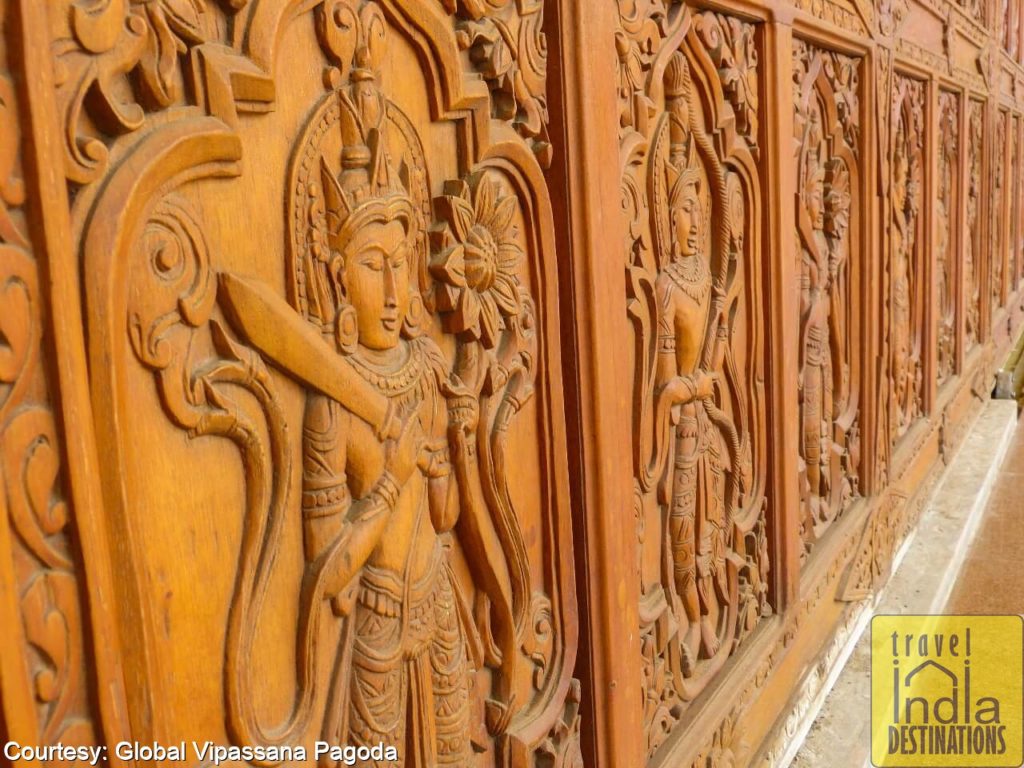
Door Carvings on Gate No 1
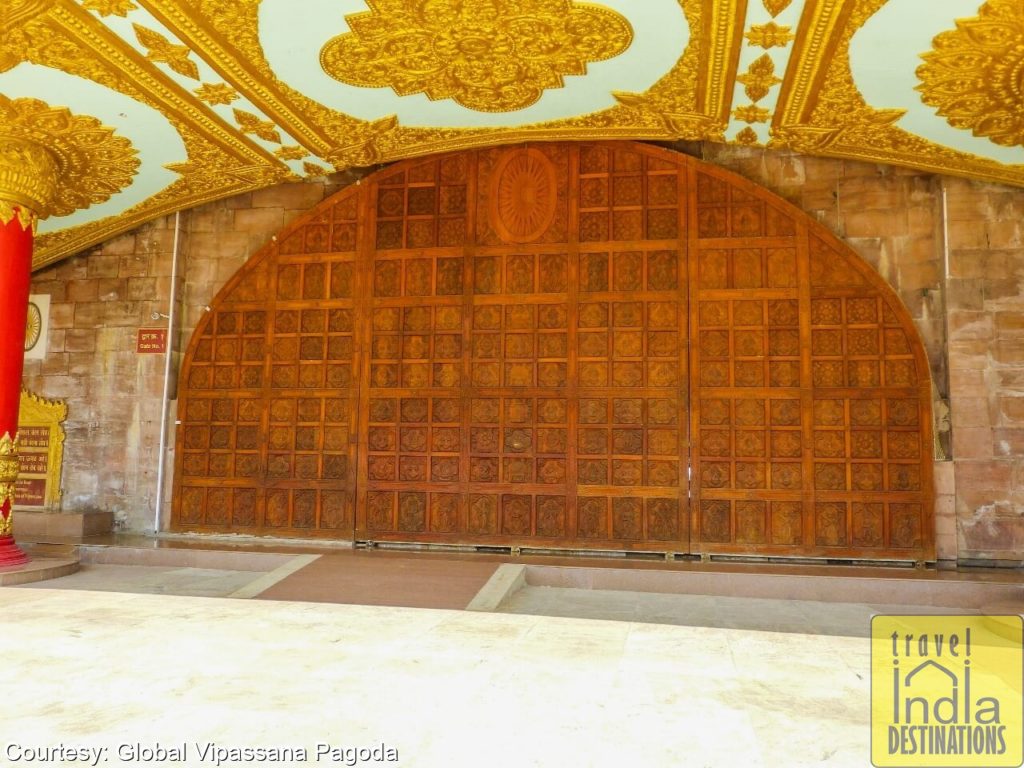
The world’s second largest Burma teak wood door.
Dhamma Pattana Vipassana Centre
Dhamma Pattana is where old and new students conduct residential Vipassana courses. You can enter the premises only if you have taken up the Vipassana courses. The building has AC rooms for accommodation, a large Dhamma hall along with two mini halls.
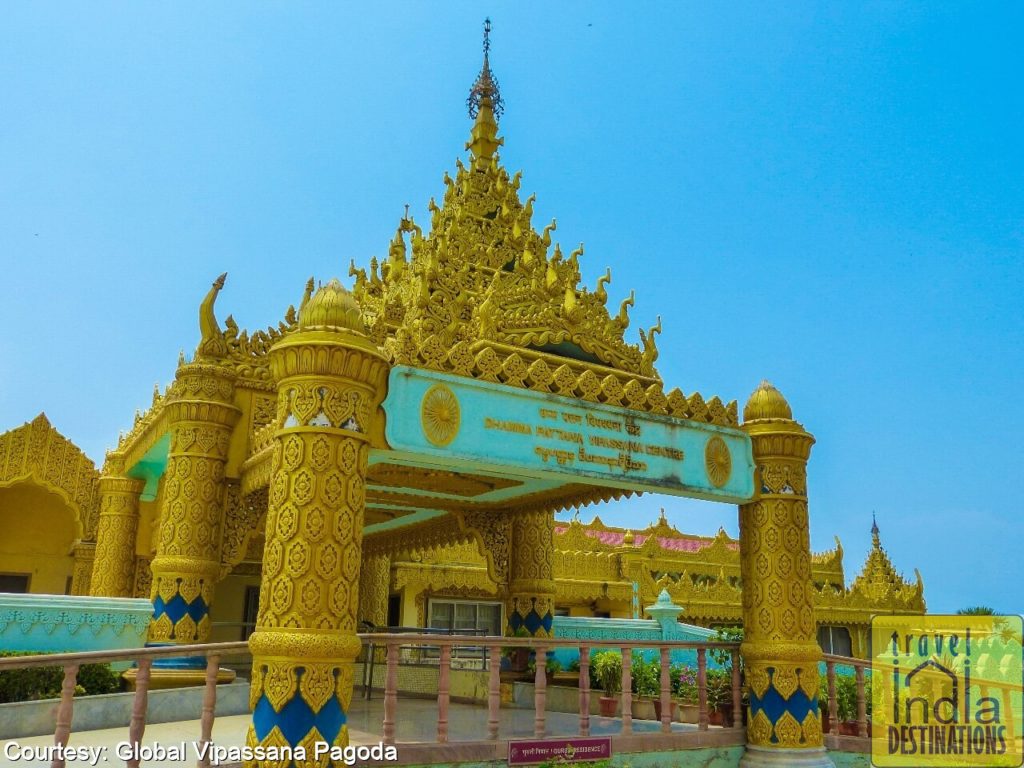
Dhamma Pattana Vipassana Centre
South Pagoda
The South Pagoda is right next to the Dhamma Pattana and is an integral part of it. The structure has cells for individual meditation. These cells allow meditators meditate without distractions.
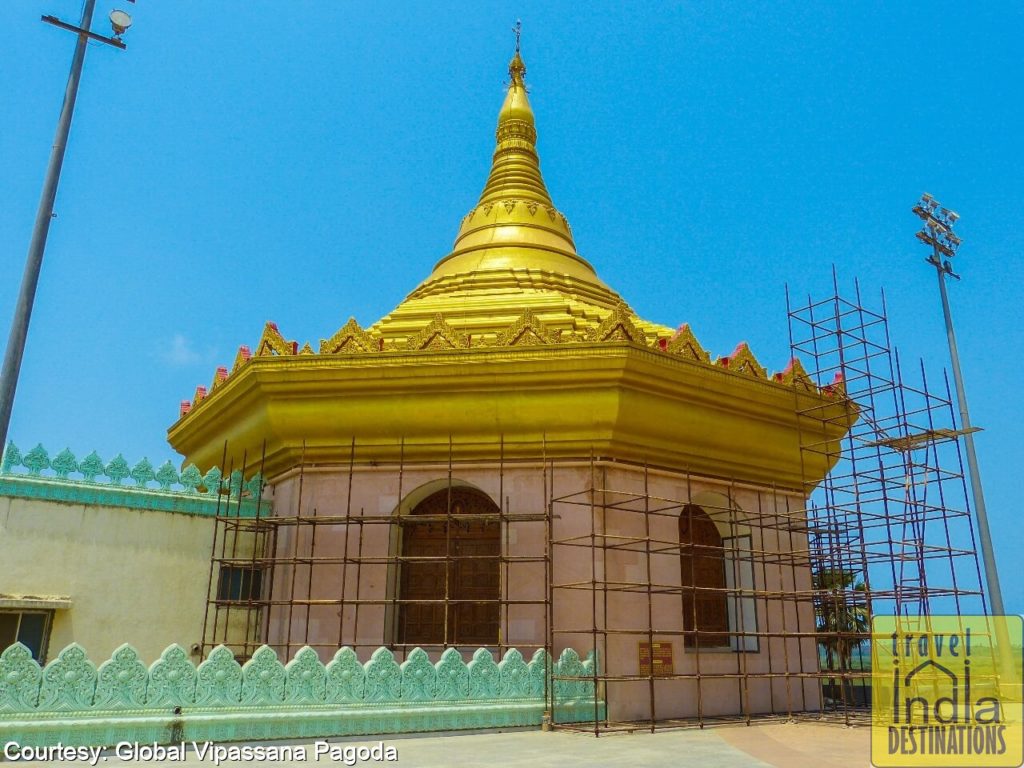
The South Pagoda
Discourse Hall & Painting Gallery
After completing your circular tour around the main pagoda you return to the stairs you climbed up. When you climb down a few steps and take a left you come across a Discourse Hall where you can see the pictures of the construction of the Global Vipassana Pagoda. You also see a video gallery and the painting gallery. The painting gallery is something which you should not miss out if you ever visit this place. Here you see 122 paintings of the Buddha’s life and teachings.
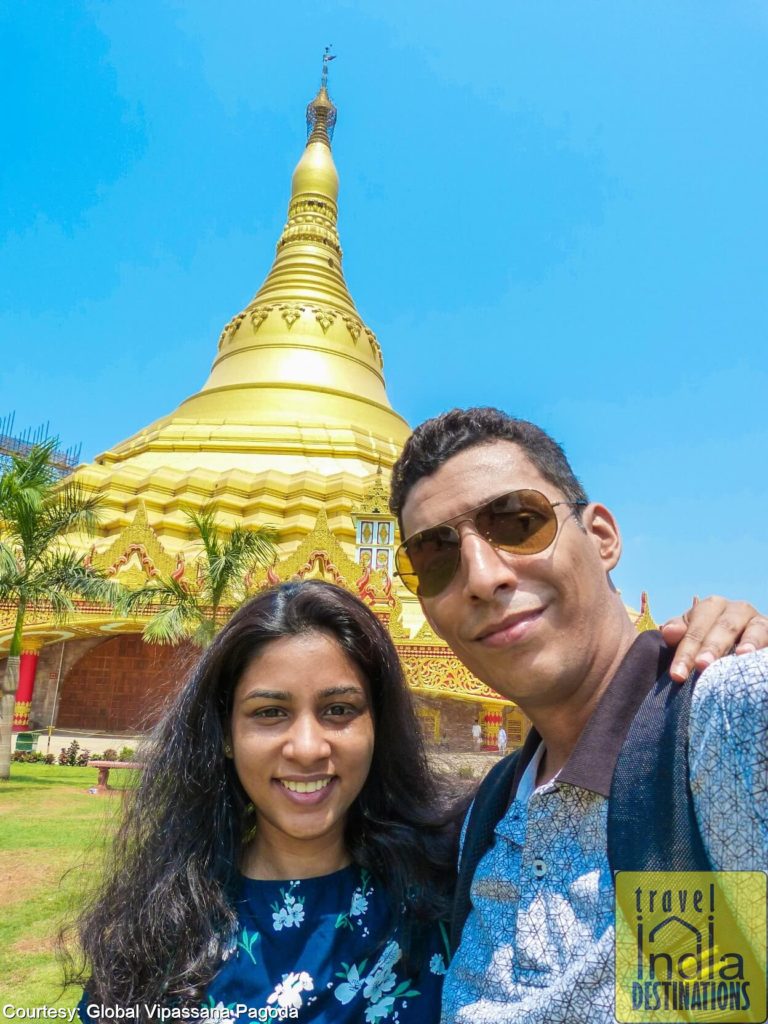
A selfie time at the Global Pagoda
Each painting tells a story from Buddha’s life and highlights the history of 2500 years of Buddha sasana. You need to switch off your mobile device and camera before entering the gallery. The painting gallery provides you with the audio device available in 6 languages to help you listen to the story behind every painting. It is a unique experience that captures you right from the first painting.
Souvenir Shop
On your way down to Myanmar Gate, you come across Souvenir Shop where you can buy some items. It has everything you can think of like books, decorative pieces, key chains, pen sets, bags, t-shirts, caps, and much more. You cannot take pictures in the souvenir shop.
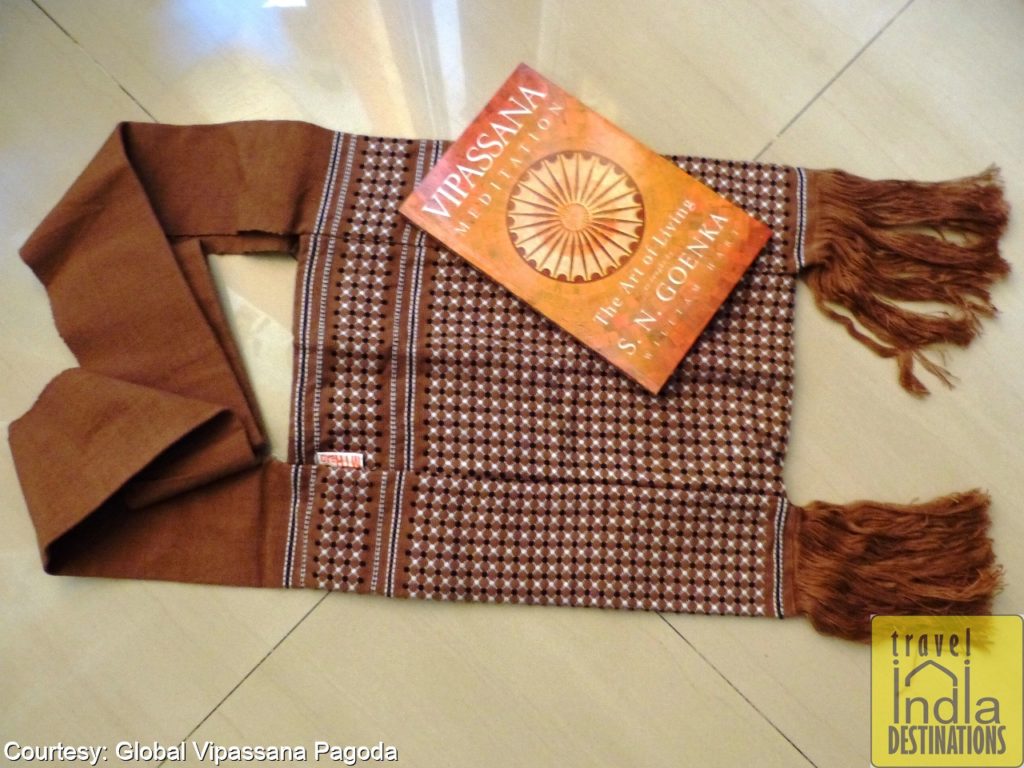
I bought this Burmese style bag and a book.
Sanchi Gate
If you visit the Global Vipassana Pagoda through the Bhayendar route you also come across Sanchi Gate which is a replica of the main gate of Sanchi Stupa in Madhya Pradesh. This gate is built in the memory of Emperor Ashoka for his contribution to spreading Dhamma outside India.
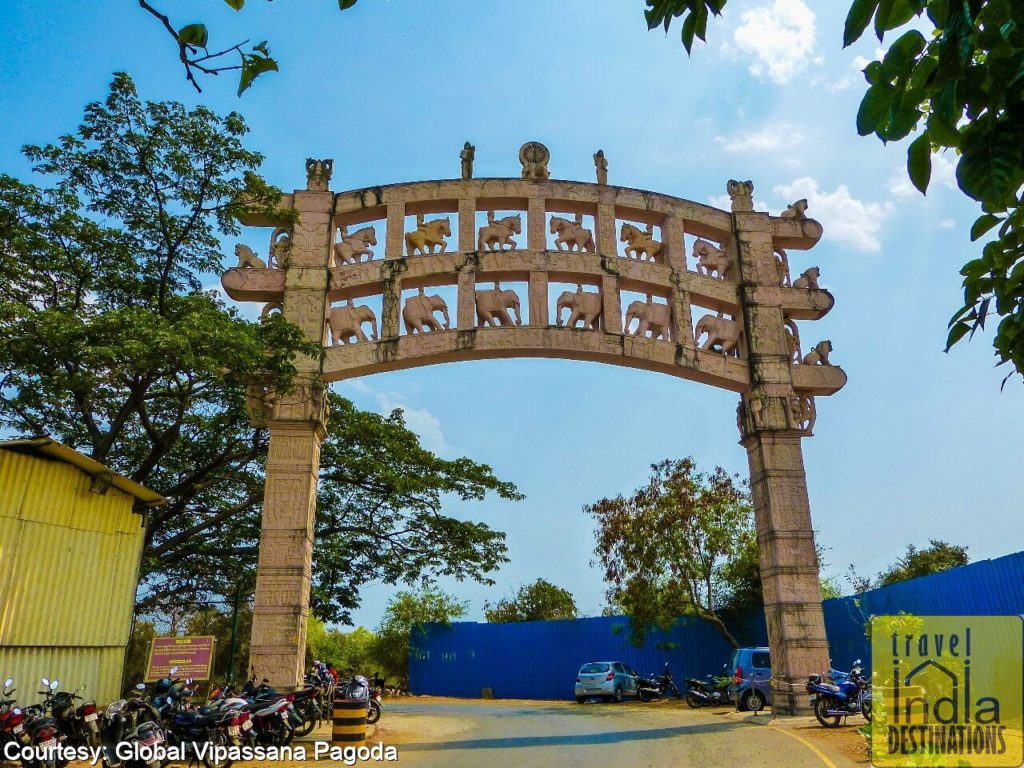
Sanchi Stupa Gate
Conclusion
If you are in Mumbai, Global Vipassana Pagoda is a place you must visit. There is no entrance fee. However, you are free to donate to the organisation on your free will. This place is ideal for those seeking some peace of mind. The atmosphere is soothing and relaxing. This is not a place of worship and therefore people from all walks of life and caste and creed are welcome here.
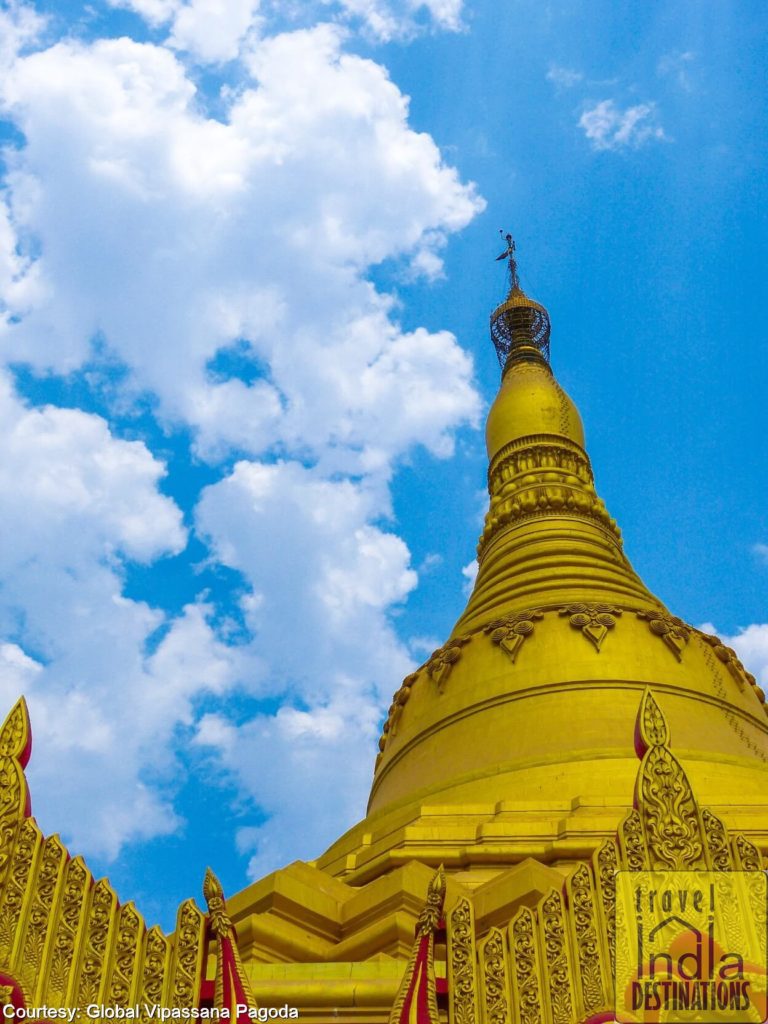
The Global Pagoda
Of course, I would like to take this opportunity that this is not a picnic spot. If you’re looking for some entertainment or one-day picnic place with kids, this is not the place for you. However, if you want to explore the architecture, history and culture and teachings of the Buddha you can visit it. It is one of the Seven Wonders of Maharashtra by the Maharashtra Tourism Development Corporation (MTDC). Undoubtedly, Global Vipassana Pagoda is a beacon of peace and harmony in India.
12 comments
Wow, Sharukh. I would want to visit here first thing on my trip to India. After meeting you and Sarah first of course! 😀Thank you for such a beautiful and informative tour. I very much enjoyed reading the story of the Buddha in my recent past. I appreciate the aspects of his teachings, his life and how it unfolded. Simply stunning structures. Cheryl
I am glad you enjoyed the entire post. It got a bit longer than I had anticipated but the pictures would keep the readers from getting bored. Thank you for commenting, Cheryl.
This place is amazing and in beautiful condition given the age. I love the colors. I enjoy learning about history, anywhere in the world, and this was a joy to read. I love the photos,especially the doors!
I’m glad you loved it. Those door pictures are specially for you. More door pictures coming up the next Tuesday with more history.
Another beautiful post, full of blue skies and gold. Love Gate No 7 — Amazing!
Thank you, Joey. Well, I don’t participate in Thursday Doors like you guys, but whenever I get some lovely door pictures, I add it to my blog as a tribute to Thursday Doors. I am glad you liked the post and pictures.
Shahrukh the place is so magnificent and indeed your true calling. One can sense divinity in the sculptures, awe inspiring building, domes and surroudings. Next time I am in the city I should check your blog and make a list of places to visit.
Cheerz mate
Vishal
Thanks, Vishal. The experience is definitely a good one. A must-visit when you are in the city.
SPECTACULAR…!!!
Thank you, Kshitij. Your comment means a lot to me. 🙂
I read halfway through yesterday and finished this morning. An amazing place… I’d love to visit.
And you are right, an amazing built structure!
A couple of things:
“Lions” were actually stylized chow dogs, which were warrior dogs of the Samurai and fierce guardians.
The peacock can eat poison, and live, and Buddhist call “sins” (hard to translate in Western terms) poisons of the mind — therefore in the Buddhist culture, peacocks are a wisdom symbol.
The shape of the Pagoda temple top is in the shape of the topknot warn by many teachers, and is called a stupa. Most stupas contain a treasury — from bodies of deceased teachers, to written treasures, to offerings.
And even those of most religions can practice Vipassana! (Unless their religion is restrictive…)
Finally, in bowing to the Buddha you are bowing to the enlightened being inside you…
Namaste! _/\_
I’m glad that you liked the post. Thanks for the additional information, Kate.